Byzantine-coin legends. How to read Byzantine coins.
This page is intended to help readers understand Byzantine coin legends. The essential reference is Byzantine Coins and Their Values, second edition, by David Sear (cited as "Sear" below). It has many legends translated on pages 33 and 34. Nevertheless, there are other legends that collectors would like to have expanded and translated and this page can help.
(For Roman coin legends, see here: http://www.bitsofhistory.com/info/roman_inscriptions.html )
What's new? 2024, Dec. 12: Image sizes increased. 2023, May 6: "ET" on Sear 395. 2022, July 30: Sear 1001 with OΦA down the left. 2022, Jan. 21: A miliaresion of Constantine VII, Sear 1757, with his name/title "Porphyrogenitus". 2021, Dec. 16: A better example of Sear 1911 for Alexius I.
Contents: A sampler of legends.
Numbers. Individual letters.
Abbreviations and words (early, before 970) (Late, after 970).
Emperor's names. Mints. Monograms. Examples in order of Sear number. References and acknowledgements.
(For an introduction to Byzantine coins, see: http://augustuscoins.com/ed/Byz/ )
Comments. English uses spaces to separate words--Byzantine-coin legends do not. Wordsruntogether. The spaces used below to separate words are not on the coins.
Byzantines identified themselves as Romans and, although legends use Greek, many Latin words and letters continue to be used, even on coins with Greek letters.
Obverse legends usually begin at 7:30 (the lower left) and read clockwise.
This page has many links to coins that illustrate the legends. If you click on a link, use "back" to return to where you were.
Almost all legends on copper coins are addressed. Silver and gold coins may have unusual legends not addressed here.
A Sampler. Next are four examples from different time periods: Early (AD 491-7th C.), Middle (8th-10th C.), Anonymous (AD 970-1090), and Late (AD 1059-1453).
A Sampler: The early period with denominations M, K, I, Є, etc. in Greek on the reverse.
Sear 372: Emperor Justin II with his wife Sophia (565-578). 30 mm. 12.35 grams. Common.
 The obverse legend gives the emperor's name and titles, clockwise from 7:30:
The obverse legend gives the emperor's name and titles, clockwise from 7:30:
DN IVSTIN-VS PP AV
DN = Dominus Noster ("Our Lord" in Latin.
IVSTINVS = Justin.
Greek and Roman have no "J". They used "I". Also, names of emperors in Latin usually end in "VS" which is commonly omitted in English. So, emperor Justin II (565-578) has the name "IVSTINVS" on coins. If an emperor has a numeral after his modern name, such as "II", the numeral is never on Byzantine coins. You have to figure out which "Justin" it is some other way.
PP = Perpetuus = perpetual, forever
AV = Augustus = emperor
Reverse: The large M gives the denomination M = 40 (nummi), in Greek. To the left is ANNO (as in "annual") for "year" and to the right is the year of his reign. 6+1 = 7, the 7th year of Justin II. (That G-like symbol is for "6"). In the exergue (at the bottom, below the horizontal line, is "KYZ" for Kyzikos = Cyzicus, the mint (not far from Constantinople, but on the Asian side).
Below the middle of the M is a Greek "A" (Alpha, for "1", identifying the coin as from the first officina [first workshop of the mint]). Note how the crossbar is not a horizontal dash, rather more v-like:  . Similar coins may have officina number "B" (Beta) for "2", "Γ" (Gamma) for "3", "Δ" (Delta) for "4" or "Є" (Epsilon) for "5".
. Similar coins may have officina number "B" (Beta) for "2", "Γ" (Gamma) for "3", "Δ" (Delta) for "4" or "Є" (Epsilon) for "5".
Skip down to other types of the early period.
Sampler, continued: The middle period. Obverse legends begin with the emperor's name without "DN" and many reverses consist entirely of legends.
Sear 1729. Leo VI, "The Wise" 886-912. 27 mm. 7.96 grams. Very common.

Obverse, clockwise from 8:00:
+LЄOҺ bAS-ILЄVS ROM'
Leo, emperor of the Romans [Byzantines]
Reverse in four lines:
+LЄOҺ Leo
ЄҺ ΘЄO BA "by the grace of God" ["in God']
SILЄVS R emperor of the Romans [Byzantines]
OMЄOҺ (the "Һ" is an "N")
Skip down to other types of the middle period.
Sampler, continued: Anonymous folles. In 970 emperor John I initiated the "anonymous" series. They are anonymous because the name of the emperor is not on the coins. The types are named alphabetically "Class A" thorough "Class K" and the classes are attributed to emperors by scholarly methods addressed on my pages about "anonymous folles": http://augustuscoins.com/ed/ByzAnon/
Sear 1813. An anonymous follis of Class A2, attributed to Basil II ("The Bulgar Slayer") and Constantine VIII, 976-1025. 28-26 mm. 11.28grams. Very common.
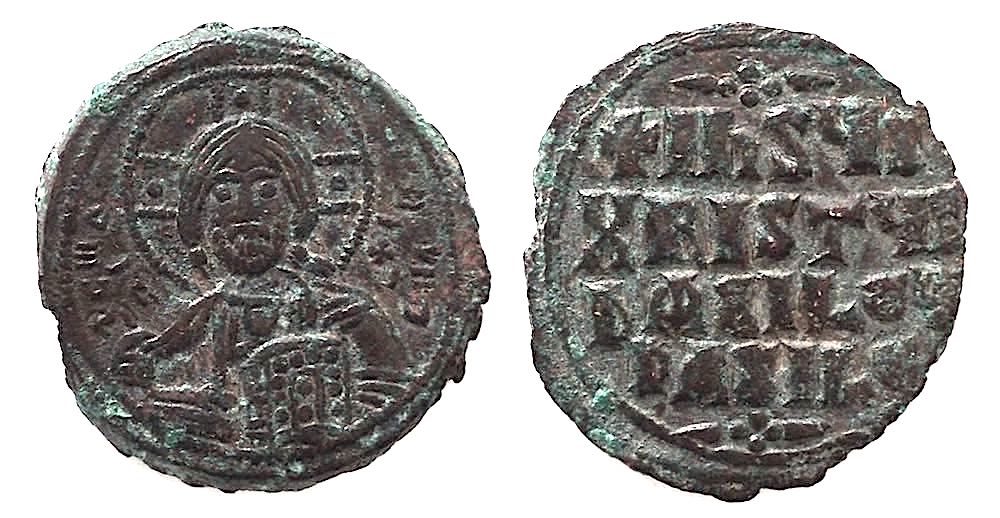 Reverse: Legend in four lines with ornaments above and below.
Reverse: Legend in four lines with ornaments above and below.
+IhSUS (Jesus)
[Greek and Roman have no "J"; "Jesus" is spelled with an "I"]
XRISTUS (Christus = Christ)
["X" is "Chi"in Greek, = Ch]
bASILЄU (King of [The "A" is elaborate]
bASILЄ (kings)
Obverse: Bust of Christ facing, ornaments in his "nimbus" = halo.
+ЄMMA NOVHA "God is with us" from 8:00.
In small letters either side of the bust at chin level around the halo (nimbus) is IC XC, abbreviating "ΙΗΣΟΥΣ ΧΡΙΣΤΟΣ" = "Jesus Christ". (The short bar above means it is an abbreviation. On this coin those letters are not horizontal and not well-engraved. (A different example of this type is below.)
Go to a separate page on anonymous folles.
Sampler, continued: Late Byzantine coins. Late Byzantine coins almost never come with complete and well-struck legends. Often almost no letters are legible and attribution usually requires identifying the design by comparison with illustrated coins in a reference work. Any coin with a legible legend is worth a substantial premium.
Sear 1966. A trachy (cup-shaped coin) of Manuel I (1143-1180). 30-29 mm. 3.27 grams. Common.
 The obverse is the side that bows out. It is usually worn and double struck. On this example, the left and right sides of the head of Christ, his body, and his throne are not quite in line. That is, unfortunately, normal.
The obverse is the side that bows out. It is usually worn and double struck. On this example, the left and right sides of the head of Christ, his body, and his throne are not quite in line. That is, unfortunately, normal.
Still legible is
IC (with a bar above) to the left and XC (with a bar above) to the right. The "C" is a lunate "S". The "X" is a Greek Chi = Ch. The short bar above means it is an abbreviation.
IC XC is for "Jesus Christus".
Reverse: The reverse shows the Virgin Mary crowning the emperor Manuel.
MANɣHΛ ΔЄCΠ (Manuel Despot/emperor) "Manuel" begins at 7:30. "Despot" at 3:00.
Supposedly the Virgin has M ΘV (Mother of God) with the M above and ΘV to the right. Here, only the Θ is clear at 2:30.
This reverse has at least MAN and ΔЄCΠ legible, which is more than can be read on most examples. Reverses are usually unworn-- the design is in the interior of the cup which protects it from wear. Nevertheless, the reverses are often so ill-struck that the legends are not legible. Also, the words may have more or fewer letters spelled out. For example, ΔЄCΠ (for "despot") may omit the Π, ΔЄC, or may be longer: ΔЄCΠOT. Legends are so erratic that two coins are considered the same "type" even if their legends differ by a letter or two.
Skip down to other types of the late period.
Numbers and Numerals. Byzantine coins have letters and numerals in both Latin and Greek. Often on a single coin the denomination is given by a Greek numeral and the date is given in Roman numerals (above, Sear 372). Latin letters and Roman numerals cause few problems. Here we discuss the English equivalents of numerals and letters.
Roman numerals: XXXX = 40, XXX = 30, XX = 20, X = 10, V = 5, I = 1 (Be careful, "I" as a year is the Roman numeral "1", but "I" as a denomination is the Greek numeral "I" for "10" [Sear 236]). Also, in dates, ɥ =  (with a tail on the lower right, Sear 428 and Sear 430) is also V = 5. S = ς (which looks more like a G) =
(with a tail on the lower right, Sear 428 and Sear 430) is also V = 5. S = ς (which looks more like a G) =  = 6. So 7 can be "GI" (Sear 372) or "VII" written as "ɥII". The numerals for dates are also discussed on page 31 of Sear.
= 6. So 7 can be "GI" (Sear 372) or "VII" written as "ɥII". The numerals for dates are also discussed on page 31 of Sear.
Greek numerals: M = 40, K = 20, I = 10, Є = 5, and Δ = 4, Γ = 3, B = 2, and A = 1. Numbers 4 through 1 are rare as denominations but common as officina (mint workshop) numbers. Rarely we see Λ = 30, H = 8, and S = 6.
Greek Letters. Many letters (e.g. A, B, E, I, K, etc.) have different names in Greek but function phoenitically just like they do in English. Generally Greek letters on ancient coins are upper-case letters, so the upper-case versions are given here.
A Alpha = 1 as a numeral (common as a letter and an officina number, rare as a denomination. Sear 281).
B Beta = 2 as a numeral (common as a letter and an officina number, rare as a denomination. Sear 270).
b beta. In later Byzantine coins the letter often has no top loop and the letter is a vertical stroke with a slight widening at the bottom (Sear 1823).
Γ Gamma G (As a numeral, it is 3. Sear 430.)
Δ Delta D also, occasionally ∂ (of various shapes, sometimes almost backwards as "G") = D as in Dominus Noster
(As a numeral, Δ is 4. Sear 194 and Sear 610 as a denomination. Sear 812 as an officina number)
Є Epsilon E (As a numeral, Є is 5. Sear 170)
Z Zeta Z (As in "ZOH" for our "Zoe". Sear 1758)
H Eta E (not H) (As in "ZOH" for our "Zoe". Sear 1758). As a numeral, it is 8. Sear 192, Sear 605)
Θ theta Th (On Roman coins, but not Byzantine coins, it can be "9". It can be a meaningless symbol. Sear 1642)
I Iota I (As a numeral, it is 10 in Greek (Sear 236). Do not confuse it with the Roman numeral I = 1.)
K Kappa K (As a numeral, K is 20. Sear 231) The shape “C”, often used for "S", is sometimes used in place of "K". Sear 1758)
Λ Lambda L (Rarely it is a numeral, 30. Sear 812)
M, m Mu M (Very common as the numeral 40. Sear 372 . For the m shape, Sear 430)
Һ = N (Һ is shaped like our lower-case N, n, with a taller left stroke)
Ξ Xi X
Π Pi P
P Rho R (not the English P)
R a Latin shape sometimes used for "B" in the 11th C. (Sear 1854, Sear 1866) and sometimes for "R" (Sear 1754)
S, C, Σ Sigma S (The Greek-shaped "Σ" does not appear on Byzantine coins. It is appears as "S" or a lunate "C".
For example, "Jesus" may be abbreviated "IC" (Sear 1825) or "IS" (Sear 1823).
Σ see "S" immediately above.
Φ Phi F (We spell "Phocas" and "Theophilus" (Sear 1642) with "Ph", but they used "F")
T Tau T Sometimes shaped  .
.
ɣ A ligature for OV = OY.
X Chi Ch (not X) As in "Christus" = "Christ" (Sear 605, Sear 1825)
Ψ Phi Ps (Rarely seen)
Ω Omega O (The upper-case version. This is a letter which is used in both upper-case and lower-case shapes)
ω omega O (Now ω is used for lower case. Nevertheless, it is often seen on coins. Sear 1853)
Comments: The Greek epsilon, our E, is shaped Є.
J Greek and Latin have no "J". They used "I". For example, "Justin" is "IVSTINVS" on coins.
"A" usually has a crossbar which is not horizontal, rather like a "v":  . (Sear 372, with it both as a letter and as a numeral)
. (Sear 372, with it both as a letter and as a numeral)
"K" is often rendered "C" in English, so "KωҺ" abbreviates "CONstantine." (Sear 1853)
' is a symbol sometimes used to indicate there are missing letters (an abbreviation, as we employ in "don't"). (Sear 1754)
A bar across the top of two letters in indicates an abbreviation (Sear 1825, Sear 1867), e.g. IC with a bar across the top for "Jesus".
Words and Abbreviations:
Early coins first (AD 491-970). Legends on late Byzantine coins--anonymous folles and later--are below.
AISP The "IS" is "10+6" = "16", a denomination used only at Thesssalonica (Sear 176) (the mint also used denominations Δ = 4, Sear 194, and H = 8, Sear 192).
ANA NEO [CIC] or ANANEOSIS = "renewal" (Sear 1005) [of good times, much like "FEL TEMP REPARATIO" in the 4th century]
ANNO = year (as in "annual") of the emperor's reign, the "regnal" year (Sear 372). It begins with "1" when he begins his reign. It was used beginning with year 12 of Justinian, 538/9, and ending in the eighth century. Sear lists the AD years that correspond to each regnal year.
A P on either side of the denomination on coins of Thessalonica (Sear 176) . The meaning is uncertain. "Most probable [is], Arca Praefecturia, denoting the office responsible for coin production or provision of the metal" according to Hahn in MIBE, p. 64.
AVGOUST = Augustus = emperor (Sear 1668)
AV = AC = AVC = AVG = Augustus (emperor)
bASILEVS "emperor" or "ruler" (or "king" in "king of kings")
bASILEVS ROMЄOҺ "Emperor of the Romans." "Romans" means "Byzantines." (Sear 1729) Very common in the middle period and later.
BITA, see "VITA" ("B" and "V" are phonetically similar.) (Sear 400) [B in modern Greek is pronounced like V, so this is evidence of the change having occurred by the 6th century.]
bOHΘ' part of ΘΕΟΤΟC' bOHΘ' [see below] the plea, “Mother of God, give aid…”
CЄ "and" Here the "C" is not an "S", rather a "K", for "KAI" ("and") as in "Constantine and Zoe" on Sear 1758.
DN or ∂N Dominus Noster ("Our lord" in Latin. On early Byzantine coins it begins many legends, starting at 7:00, immediately before the name of the emperor.) Sear 372, above.
∂ЄЧS A∂IЧTA ROMANIS "May God help the Romans" (Sear 996)
ЄҺ "in" (Sear 1729, Sear 1754)
ЄҺ TɣTω NIKA or
ЄN TɣTo NIKA "In this, conquer," the Greek version of "In Hoc Signo Vinces" or "HOC SIGNO VICTOR ERIS" (Sear 1005).
ЄҺ ΘЄO "by the grace of God" (Sear 1729). Greek for this is "ЄN ΘЄΩ", literally "in God." Common on reverses in the middle period, as in "Leo, by the grace of God, king of the Romans".
ЄC ΘЄɥ also "by the grace of God" (Sear 1595). Here the "C" is not an "S", rather a "K". ЄC ΘЄɥ = EK ΘЄOY = "from God" = "Dei Gratia" (in Latin) = "by grace of God".
ET "and" (Sear 395)
ЄVSЄb[HC] "Pius" (Roman), pious (English) (Sear 1754)
ΘЄOTOC ' bOHΘ' = ΘΕΟΤΟCЄ ΒΟΗΘΕΙ, the plea, “Mother of God, give aid…”
ΘKC (with bar above the "KC") abbreviating "Theotokos" = "Mother of God" in Greek. Sear 366.
IMPERAT "Imperator" another title meaning "Augustus" = "emperor." Sear 1693.
KAI "and"
MEGAS great
NEO part of ANA NEO for ANANEOSIS = "renewal" (Sear 1005) [Of good times, much like FEL TEMP REPARATIO is in the 4th century]
N M "nummi" (Sear 400)
O/Φ/A Abbreviation for "officina" in Greek OΦΙΧΧΙΝΑ only on coins of Constans II (Sear 1001)
PISTOS faithful
PP = Perpetuus = perpetual, forever (Sear 372)
PERP is it, expanded (Sear 839)
ΠORFVROΓ' "Porphyrogenitus" "Born in the purple" (i.e. His father was emperor when he was born), Sear 1757)
X N
X N
X N on either side of a large "M". An "immobilized" type which blunders the previous "ANNO/year" format. (Sear 1642)
REX "king" (A title anathema to Romans and only used once on Byzantine coins. Sear 1693)
ROMЄOҺ "of the Romans [Byzantines]" (Sear 1729)
S "with" between names when there are two (Sear 1730 on a reverse, Sear 1642 on an obverse). Common in the middle period. S is sigma, the first letter of the word ΣΥΝ, which means “with”.
S is sometimes used for the number "6". S for στιγμα (stigma), a letter which existed when the numbering system was devised, but had disappeared from classical Greek.
SV ҺICAS "may you conquer" (Sear 1668)
VITA = "life" (on coins of Justin II, only at Carthage, Sear 400) as part of an acclamation.
XЄPCONOC Cherson. (Sear 605). Here is a page on coins of Byzantine Cherson. [Remember, the "X" is our "Ch" and the "P" is our "R"]
Words and Abbreviations: Anonymous folles and later (970-end)
AΓIOC "Saint" [the name of the saint follows]
bASILEVS "emperor" for emperors, "king" if in "King of kings," for Christ (Very common)
B and a backwards B  (Sear 2141). A symbol of the Byzantine empire and its authority, bASILEVS, under late emperors after the fall of Constantinople in 1204.
(Sear 2141). A symbol of the Byzantine empire and its authority, bASILEVS, under late emperors after the fall of Constantinople in 1204.
ΔЄCΠOTHC = ΔЄC "despot" = emperor (Sear 1966, Sear 1987)
+ЄMMA-NOVHA "God is with us" (Very common)
IhSUS XPISTUS Jesus Christ (Sear 1595)
IC XC "Jesus Christus" (Sear 1867) with lunate "C" for "S". On late Byzantine coins a bust or figure of Christ is very common and this abbreviation is usually across the fields on either side of Christ.
IS XS ""Jesus Christus" (Sear 1823)
+IhSUS (Jesus)
XRISTUS (Christ)
bASILЄU (King of
bASILЄ (kings) (Sear 1813) (Very common)
Perhaps more precisely, “ruler of those who rule,” but "king of kings" is commonly used.
MP ΘV "ΜΗΤHΡ ΘΕΟY" "Mother of God" (Genitive) (Sear 1867). On late Byzantine coins this abbreviation is common across the fields on either side of a bust of the Virgin Mary.
Comment: A bar above letters denotes it is an abbreviation. So, the "MP" has a short bar above it as an abbreviation for "MHTHP", "Mother" in Greek.
NIKA "conquers" (Sear 1825) or (less common) NICA (Sear 1595)
C R (Sear 1866) (The "C" is a lunate "S" (sigma), "R" is an epigraphical form of "B") ΣΤAYΡЄ BOHΘЄI "O Cross, help"
["Stavros = cross"]
P Δ "Romanus Despot/emperor" RΩMANΩ ΔЄCΠOTH.
C Φ (The "C" is a lunate "S" (sigma)) ΣΤAYΡЄ ΦΥΛATTЄ "O Cross, Protect" [the emperor whose name follows]
AΛ Δ (Sear 1931) "Alexius Despot/emperor" AΛЄΞION ΔЄCΠOTH. The "AΛ" looks like "M" because the crossbar of the "A" is missing]
C Φ (The "C" is a lunate "S" (sigma)) ΣΤAYΡЄ ΦΥΛATTЄ "O Cross, Protect" [the emperor whose name follows]
N Δ (Sear 1888) "Nicephorus [III] Despot/emperor" NIKHΦωPON ΔЄCΠOTH
CЄP CΥΝЄΡΓЄΙ = CΩΤЄΡ CΥΝЄΡΓЄΙ = ΣΩΤЄΡ ΣΥΝЄΡΓΕΙ "Savior, assist" [the emperor whose name follows] (Sear 1911)
O ΔɣKAC O ΔOYKAS (the Ducas = Ducas) (Sear 2116) Unlike English, Greek puts the definite article “the” (O) before a proper name.
O AΓIOC = "[the] Saint" [named next] (Sear 2167)
RACIЄVC = BASILЄVS with "R" an 11th C. epigraphic form of "B" and lunate "C" for "S" (Sear 1854)
TOY "of the" (before a proper name) = of [the following emperor]
Tω is the dative case of the definite article, "the". "O" is the nominative.
X KI Chalkites (a particular icon of Christ over the great gate of the Sacred Palace in Constantinople, Sear 2096).
ΛΛ TH
Є
Whole legends with uncommon parts.
+KWN T ΔK ЄVΔK AVΓ (on the reverse with two figures, Sear 1853 of Constantine X and Eudocia. Common.)
KωN[Σ]Τ[ΑΝΤΙΝΟΣ O] Δ[ΟY]Κ[ΑΣ] [ЄΥΔ[Ο]Κ[ΙΑ] ΑYΓ[ΟΥΣΤΟΙ]
Constantine (the) Doukas, Eudocia, Augusti [or, emperors]
Names. The obverse legend is clockwise. It usually begins at 7:30 (the lower left). On early types it usually begins with "DN" (Dominus Noster = Our Lord) and then the name of the emperor. (Sear 372).
Names of emperors usually end in "VS" which is commonly omitted in English. So, emperor Justin II (565-578) has the name "IVSTINVS" on coins (Sear 372). If an emperor has a numeral after his modern name, such as "II", the numeral is never on Byzantine coins. You have to figure out which "Justin" it is some other way. (There are eleven emperors named "Constantine" with modern numbers I through XI and quite a few other Constantines on coins that did not rise to the throne and therefore did not get numbers. You need a reference work to tell them apart.)
In the middle period the "DN" is dropped and legends often begin with a cross,"+", before the emperor's name (Sear 1729). Reverses may name the emperor and his heirs, connecting their names with "S" for "with" (Sear 1730).
In the late period the obverse often depicts Jesus Christ or the Virgin Mary, in which case the name of the emperor moves to the reverse (and the leading cross may be omitted, Sear 1966).
Unfortunately, names are often abbreviated or misspelled (Sear 839) or off the flan. Getting the legend correct was not always a goal of Byzantine mints. For example, it can be difficult to decide if a coin is of Justin or Justinian when the name is blundered or ill-struck (Sear 167).
Emperor's names. Here is a list of emperor's names as seen on coins in approximate chronological order of their first appearance. However, names are often abbreviated or misspelled, so what you see on a coin may be somewhat different.
ANASTASIVS Anastasius
JVSTINVS Justin (Sear 372)
JVSTINIANVS Justinian (Sear 231)
CONSTANT Constantine
TIb, TIbЄRIЧS Tiberius (Sear 430)
MAVRIC Maurice
FOCAS Phocas
HЄRACLIЧS Heraclius
LЄOҺ Leo (rarely Leontius) (Sear 1729)
FILЄPICЧS Philipicus, very rare
IRINI , EIRINH Irene (Sear 1595)
NICFOROS, NICЄFOROS Nicephorus
MIXAHL Michael
bASILIOS Basil
ΘЄOFILOS Theophilus (Sear 1668)
ZωH, ZOH Zoe (Sear 1758)
ROMAN Romanus
XPISTOFOR Christopher (Sear 1754)
ΘЄOΔωPA Theodora
ЄVΔOKIA Eudocia (Sear 1853)
BOTANIAT Botaniates (Family name of Nicephorus III)
AΛЄΞIω Alexius
KOM Comnenus (Family name of Alexius I and following emperors)
Iω, IωAnn John (Sear 2116)
MANɣHΛ Manuel
ANΔPONIKOC Andronicus
ICAAKIOC Isaac
ΘЄOΔωPOC Theodore
ΔHMHTPIOC Demetrius (a Saint, not an emperor, found on coins of the Empire of Nicaea, Sear 2167.)
ΛACKAPHC Lascaris (Family name of Theodore of Nicaea and following emperors, Sear 2141)
ΔɣKAC = ΔOYKAC Ducas (Family name of John III and others, Sear 2116)
Mint abbreviations. Mintmarks are common in the exergue (at the bottom of the reverse) on early Byzantine coins. The most common mints are first. (There are many variant spellings not listed here.)
ANTX Antioch
CON Constantinople (modern Istanbul)
KAR = CAR Carthage, in North Africa
KYZ Kyzikos = Cyzicus
NIK Nikomedia = Nicomedia
TЄS Thessaloncia
THЄUP Theopolis = "City of God," which was the new name for Antioch after the earthquake disaster of AD 528 in the time of Justinian. Here is a page discussing the many mintmarks of Antioch.
Uncommon mints:
AΛЄΞ Alexandria, Egypt
CAT Catania, Sicily
ISAVR Isauria, in central Turkey (615-617, only under Heraclius)
KYΠPI Cyprus
RAV Ravenna, Italy
ROMA Rome
SCL Sicily, the city of Syracuse
SЄLISU = Seleucia in Isauria (615-617, only under Heraclius)
XЄPCONOC Cherson. Here is a page on coins of Byzantine Cherson. [Remember, the "X" is our "Ch" and the "P" is our "R"]
(There are a few other very rare mints. Collectors with a coin from any of them are too advanced to need this page!)
Monograms. Sear lists monograms on page 32, but does not expand them. The web page
http://www.forumancientcoins.com/numiswiki/view.asp?key=monogram
is more useful because it has those monograms (and more) and also identifies the Sear numbers of the relevant coins. If you have a Sear ID number, you can find the monogram in Sear, page 32. However, if you find the monogram on page 32, Sear, unfortunately, does not tell you which Sear number it is. That website does.
Examples.
Sear 170. A pentanummia piece of Justinian, 527-565. 19 mm. 4.42 grams.
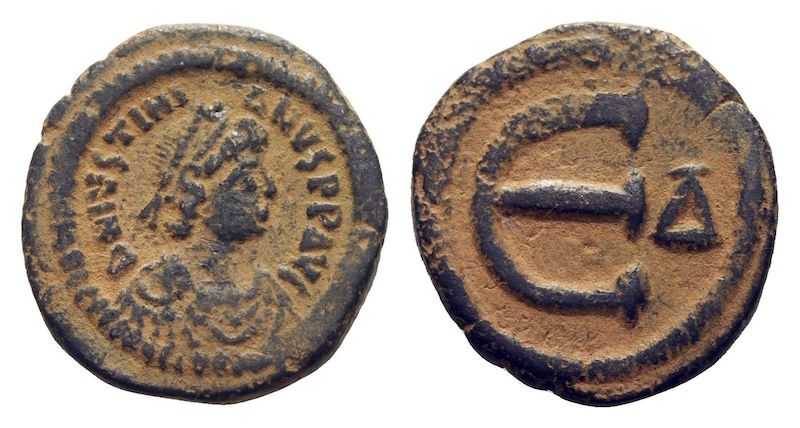
Є Δ
Reverse Є for 5 (nummi), the pentanummia denomination
with officina number Δ for 4.
DN IVSTINIANVS PP AVC
Dominus Noster Justinianus Perpetuus Augustus
Sear 176. An unusual denomination, 16 (nummi), of Justinian, 527-565, struck only at Thessalonica. 25-18 mm. 6.49 grams.
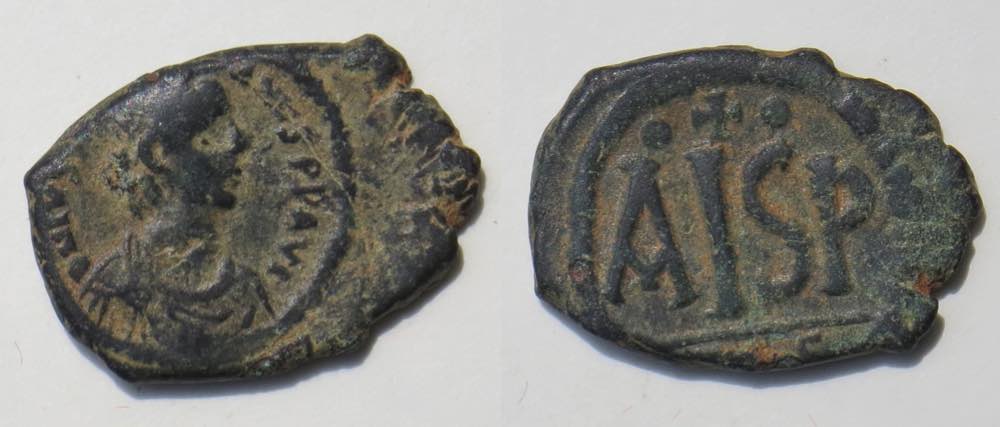 IS
IS
Reverse legend: AISP
The "IS" is "10+6" is "16" (nummi)
in exergue: TES for Thessalonica (off this flan)
The meaning of A and P is uncertain.
Sear 192. An unusual denomination, 8 (nummi), of Justinian, 527-565, struck only at Thessalonica. 17-16 mm. 2.50 grams.
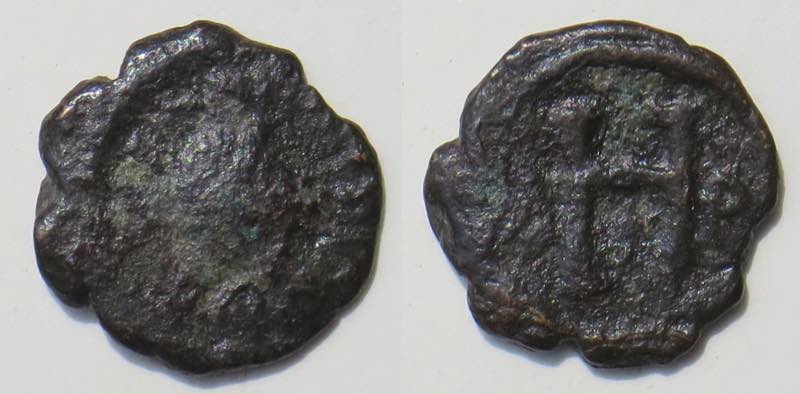
H
Reverse type: A large H (Eta) for 8 (nummi)
A P on either side.
For another use of "H" see Sear 605.
Sear 194. An unusual denomination, 4 (nummi), of Justinian, 527-565, struck only at Thessalonica. 14 mm. 1.63 grams.
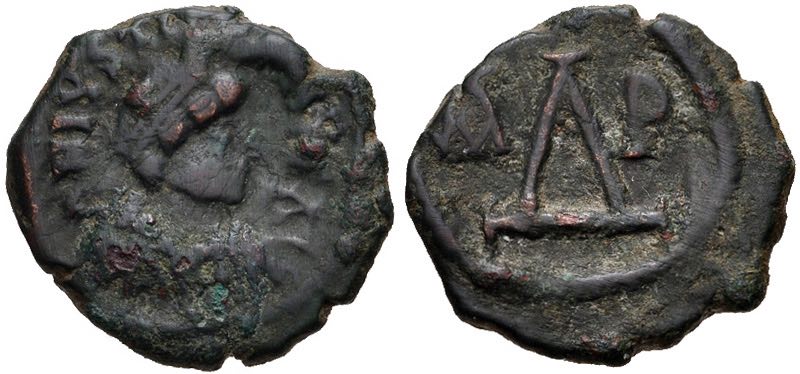
Δ
Reverse: A large Δ (Delta, D) for 4 (nummi)
A P on either side.
For another use of Δ, see Sear 610.
Sear 231. A 20-nummi piece, a half follis, of Justinian, 527-565. 27-26 mm. 9.69 grams.

K
Reverse: Large K = 20 (nummi). A half-follis.
ANNO = year
XXX = 30
The P-like symbol is one of many mintmarks for Antioch, likely "P" for "polis" = "city"
(Here is a page on the wide variety of mintmarks for Antioch = Theopolis under Justinian.)
Sear 236. Justinian, 527-565. 22-20 mm. 4.18 grams.
 I
I
" I" for "10" (nummi)
The "dekanummium" denomination.
"ANNO" for "year" down the left, "XX" for "20" down the right.
(The mintmark uses odd symbols discussed on the page of mintmarks from Antioch)
Sear 270. Justinian, 527-565. 12-10 mm.
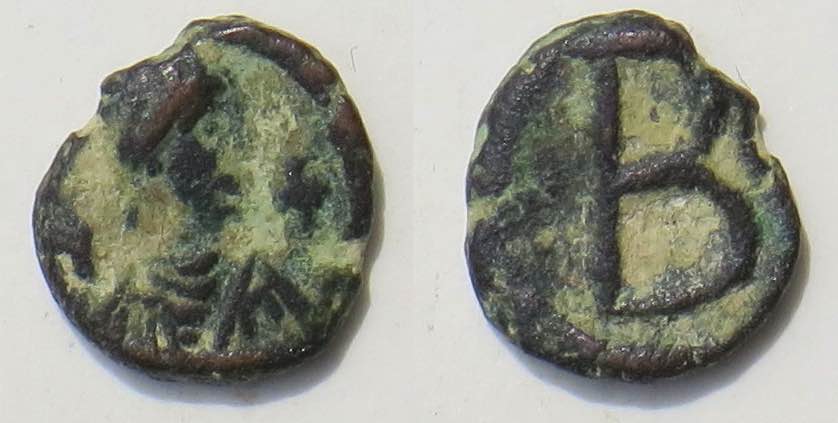 B
B
Bust right. The coin is too small to have a useful obverse legend.
Large B = 2 (nummi)
Sear 281: Justinian, 527-565. 8 mm. Tiny!
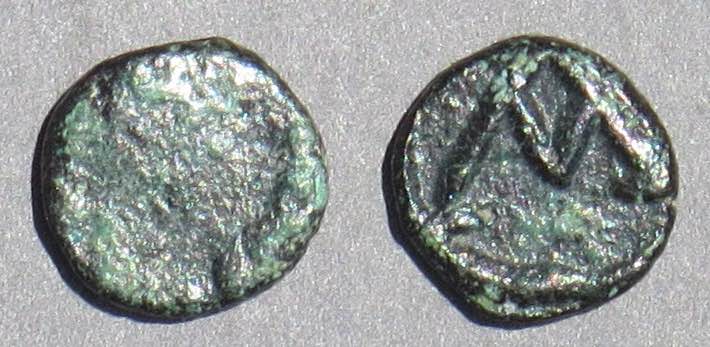 A
A
with the usual "V-like" crossbar.
The numeral "1" in Greek, for this tiny 1-nummus piece.
Sear 366: Justin II, 565-578. 21-19 mm.
 ΘKC
ΘKC
in upper field (with a bar above the "KC")
abbreviating "Theotokos" = "Mother of God" in Greek
Sear 372: [Repeated from the first four] Emperor Justin II with his wife Sophia (565-578). 30 mm. 12.35 grams. Common.
 DN PP
DN PP
M ANNO A KYZ
The obverse legend gives the emperors name and titles, clockwise from 7:30:
DN IVSTIN-VS PP AV
DN = Dominus Noster ("Our lord" in Latin.
IVSTINVS = Justin.
Greek and Latin have no "J". They used "I". Also, names of emperors usually end in "VS" which is commonly omitted in English. So, emperor Justin II (565-578) has the name "IVSTINVS" on coins. If an emperor has a numeral after his modern name, such as "II", the numeral is never on Byzantine coins. You have to figure out which "Justin" it is some other way.
PP = Perpetuus = perpetual, forever
AV = Augustus = emperor
Reverse: The large M gives the denomination M = 40 (nummi), in Greek. To the left is ANNO (as in "annual") for "year" and to the right is the year of his reign. 6+1 = 7, the 7th year of Justian II. (That G-like symbol is for "6"). In the exergue (at the bottom, below the horizontal line, is "KYZ" for Kyzikos = Cycicus, the mint (not far from Constantinople, but on the Asian side).
Below the middle of the M is a Greek "A" (Alpha, for "1", identifying the coin as from the first officina [first workshop of the mint]). Note how the crossbar is not a horizontal dash, rather more "v" like:  . Similar coins may have officina number "B" (Beta) for "2", "Γ" (Gamma) for "3", "Δ" (Delta) for "4" or "Є" (Epsilon) for "5".
. Similar coins may have officina number "B" (Beta) for "2", "Γ" (Gamma) for "3", "Δ" (Delta) for "4" or "Є" (Epsilon) for "5".
Sear 395. Emperor Justin II and Sophia, 565-578. Carthage mint, KAR, year XIII. 22 mm. 8.62 grams.

ET
Justin II (left) and Sophia (right).
Obverse legend DN IVSTIO ET SOFIA AG
with "ET" for "and".
"S" below the "K", possibly for "solo," indicating only one officina.
Sear 400. A quarter-follis of Justin II and Sophia, 565-578. Carthage mint. 20-19 mm. 4.61 grams.
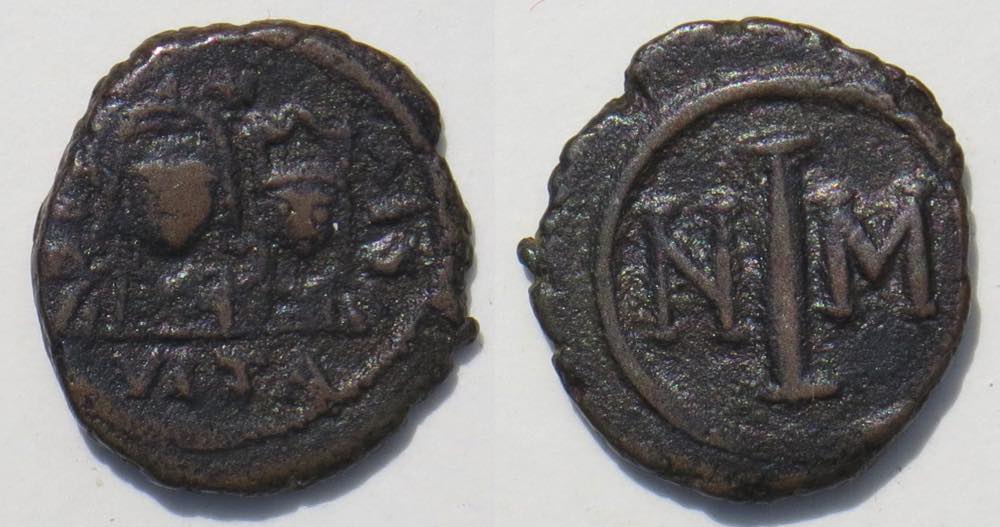 NM I VITA
NM I VITA
Justin II (left) and Sophia (right).
VITA = "life" below. The word is part of an acclamation.
It is sometimes written with "B" for "V", which is phonetically similar.
I for "10" nummi.
N M either side for "nummi," a reversion at Carthage to Vandal usage.
Sear 430. A follis (40-nummi piece) of Tiberius II, 578-582. 37 mm. 16.30 grams.
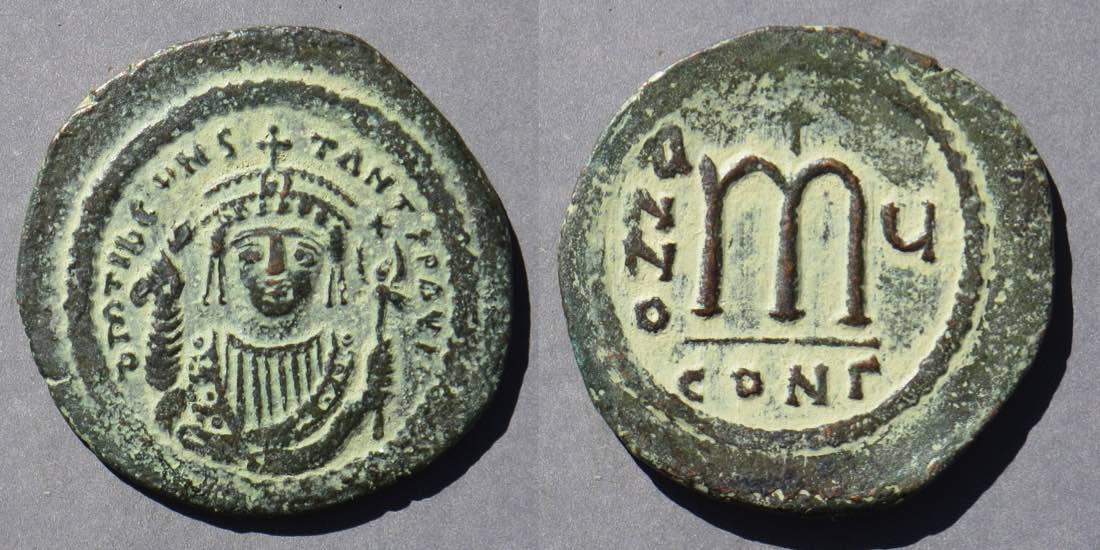 ɥ Γ m
ɥ Γ m
Dated year ("ANNO") 5 with a "ɥ" (= 5) to the right of the m (= 40) with Γ for 3, the third workshop, at the end of CON for Constantinople.
Tiberius II had been effective, if not titular, ruler for 4 years under the previous emperor, Justin II, who was insane, so he began his regnal years with 5 (and a few rarer coins from year 4).
M usually has straight strokes but is occasionally "uncial" like this rounded "m", which is most common under this emperor, Tiberius II.
Obverse legend: ∂m TIb CONSTANT ... for Tiberius Constantine who we often call "Tiberius II".
Sear 438: A 5-nummi (pentanummium) piece of Tiberius II, 578-582. 15 mm. 1.87 grams.

ɥ
ɥ for 5 as a denomination.
This symbol is is not common for a denomination.
It is more commonly seen as a numeral for year "5" in dates (above).
Sear 605. An unusual denomination, 8 (pentanummi) of Maurice, 582-602, minted only at Cherson. 33 mm. 14.69 grams.
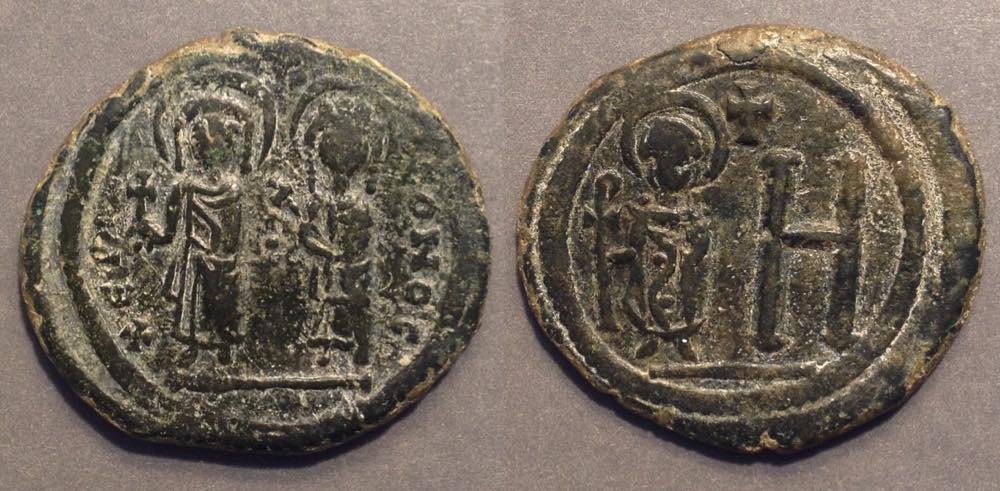 H
H
XЄP-CONOC
Reverse with "H" for 8 (pentanummi) = 40 nummi, a follis.
Obverse: XЄP-CONOC for the Cherson mint ("X" is our "Ch")
This type has no emperor's name on it.
Sear 610. An unusual denomination, 4 (pentanummi) (= 20 nummi = a half follis) of Maurice, 582-602, minted only at Cherson. 24 mm. 7.01 grams.
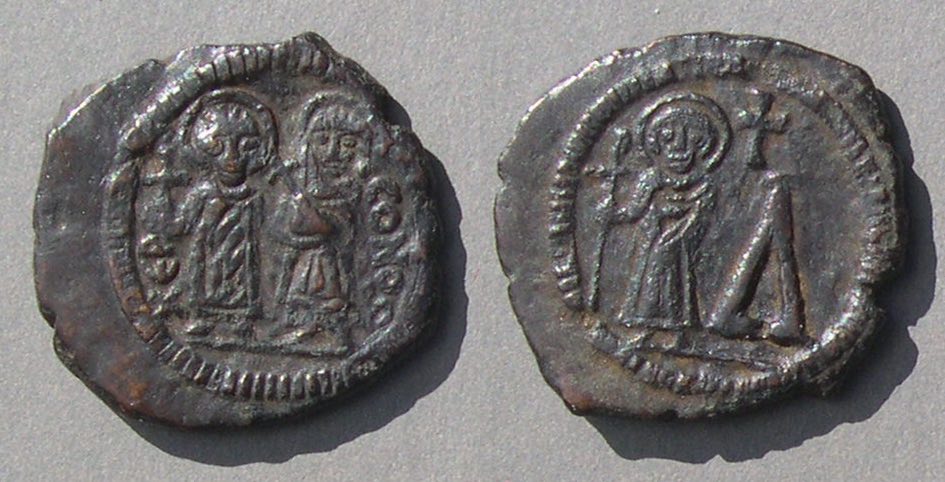
Δ
Reverse with "Δ" for "4" pentanummi, a half follis.
Obverse: XЄP-CONOC for the Cherson mint ("X" is our "Ch")
This type has no emperor's name on it.
Sear 812. Heraclius and son, 610-641. 27-24 mm. 8.99 grams.
 Λ
Λ
An unusual denomination, 30-nummi, indicated with a large Greek Lambda, Λ, for "30" (Weak on this example.)
with ANNO down the left, and XX to its right, "year 20"
Officina Δ = 4 within.
CON below is not visible on this example.
Note for collectors. This unusual type is never well struck. Obviously, the rare denominational mark is highly collectable, but the type is difficult to get nicer than this which is pretty bad.
Sear 839: A follis of Heraclius, 610-641. 32-29 mm. 11.43 grams.
 PERP AVC
PERP AVC
Year 2 (II) at Cyzicus
The obverse legend is
∂N hRAC PERP AVC
with ∂N for Dominus Noster = Our Lord
and
PЄRP for Perpetuus = forever
and Heraclius spelled
hRAC (for pronunciation, see here)
Note the shape of the "A" (for first officina) below the M. KYZ is for the mint Kyzikos = Cycicus.
Sear 849. A follis from Cyprus under Heraclius. 30-21 mm. 4.72 grams. (Very large for the type.)
 KYΠPI
Heraclius, 610-641.
KYΠPI
Heraclius, 610-641.
Three figures standing facing (Heraclius, Heraclius Constantine, and Martina)
M, with year 17 (626/7) to the right .
KYΠPI (for Cyprus) [Sometimes it is more abbreviated]
Sear 862. A six-nummi piece of Heraclius, 610-641, at Alexandria. 13 mm. 1.76 grams.
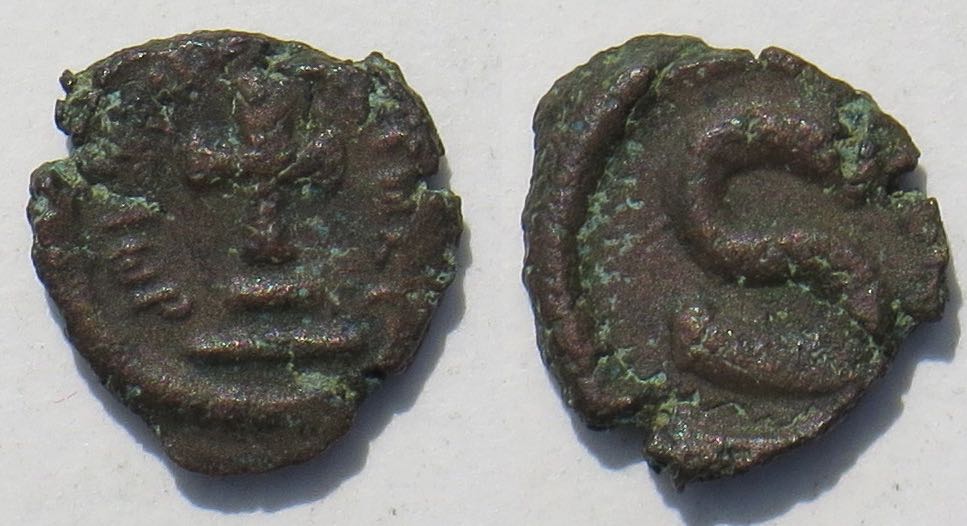 S
S
Reverse: Large S for 6.
Obverse: Cross and legend
No mintmark. Mint of Alexandria.
Sear 996. A silver hexagram of Constans II, 641-668. 23-21 mm. 4.92 grams.
 ∂ЄЧS A∂IЧTA
∂ЄЧS A∂IЧTA
Reverse: ∂ЄЧS A∂IЧTA ROMANIS
"May God help the Romans"
Obverse: Facing busts of Constans II and Constantine IV.
DN CONSTA...
Sear 1001. Constans II, 641-668. 23-21 mm.
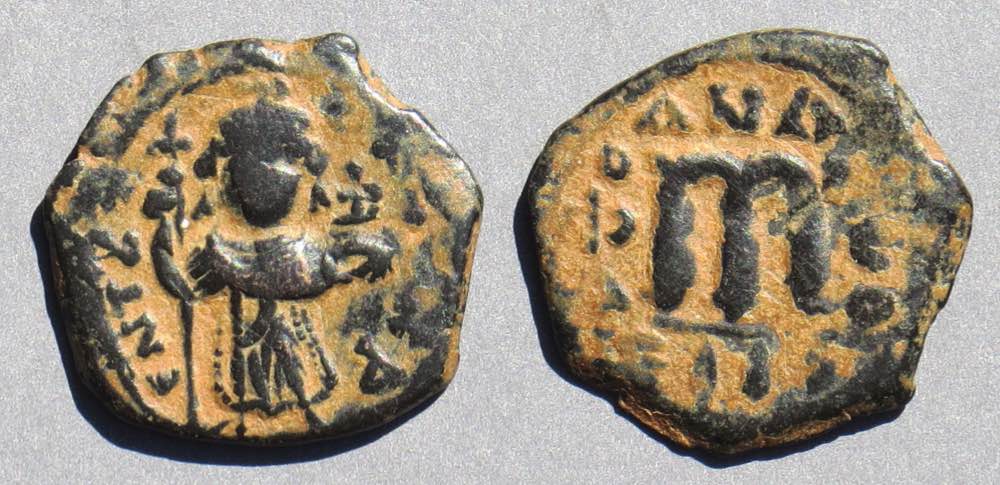 O
O
Φ
A to the left of the m
For "officina" in Greek. (The officina number is the leftmost letter in exergue, on this coin, Є)
Sear 1005. Constans II, 641-668. 22-20 mm.
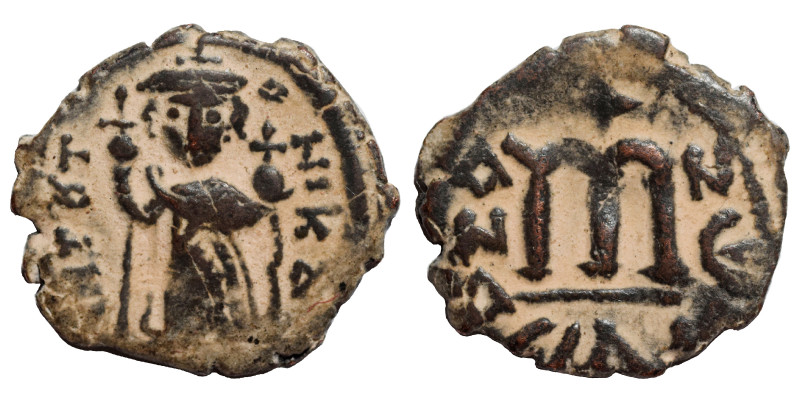 ЄN TɣTo NIKA
ЄN TɣTo NIKA
ANA NEO
ЄN TɣTo NIKA "In this [sign], conquer"
with reference to Constantine's vision at the Battle of the Milvian Bridge (in 312). The Greek equivalent of the Roman "HOC SIGNO VICTOR ERIS". (We call him "Constans II," but his real name was "Constantine" which he used on his gold, so the reference associates him with his famous namesake.)
Normally much of the legend is obscure.
ANA NEO for ANANEOSIS = "renewal" [Of good times, much like FEL TEMP REPARATIO is in the 4th century]
Sear 1595. A silver miliaresion of Constantine VI and Irene. Struck 780-797 with Irene as regent for her son. 21 mm. 2.14 grams
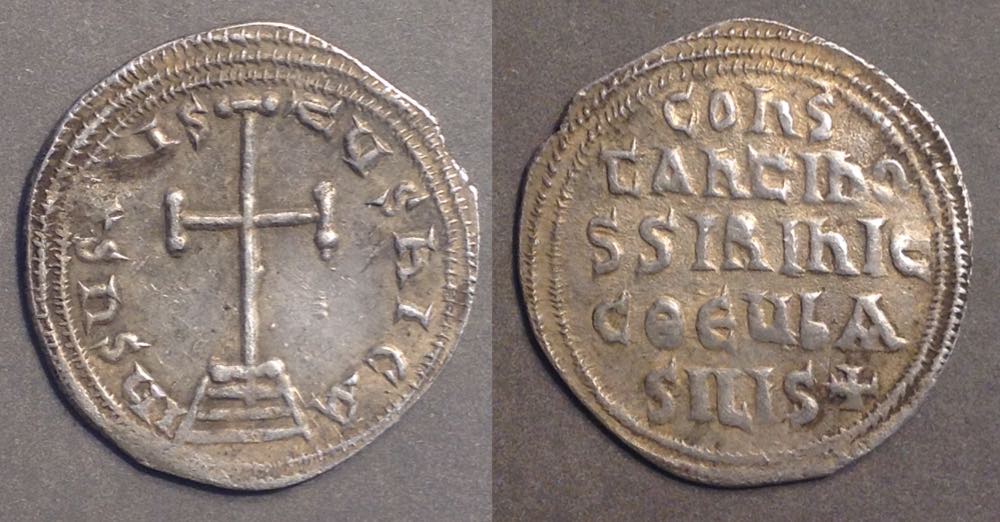 IhSɥS XPISTɥS ҺICA
IhSɥS XPISTɥS ҺICA
ЄC ΘЄɥ
Obverse: IhSɥS XPISTɥS ҺICA "Jesus Christus Conquers"
Reverse:
COҺS
TAҺTIҺO
S S IRIҺI Є ("S" = "with")
C ΘЄɥ bA (ЄC ΘЄɥ = EK ΘЄOY = "from God" = Dei Gratia (in Latin) = by grace of God)
SILIS+
"Constantinus with Irene by the grace of God emperors"
Sear 1642: A follis of Michael II and Theophilus, 820-829. 31-30 mm. 7.96 grams.
 X N
X N
X N
X N
Reverse "immobilized" type used by several emperors
with
X N
X N
X N
either side of a large M and Θ
between its legs. The "M" still means "40" for the follis, but the other symbols are meaningless. They may mindlessly copy, with left and right sides switched, some of the reverse of the next coin.
It has been suggested that "X N" might abbreviate "Christ Conquers" three times. "Christus Nika".
Obverse legend: MIXAHL = Michael (II) "S" = "and"
ΘЄOFILOS = Theophilus (They used "F" for some names we spell with "Ph", like "FOCAS" for "Phocas.")
Sear 811, Heraclius, 610-641. Year 30. 22-21 mm. 5.43 grams. A possible prototype for the immobilized type above.
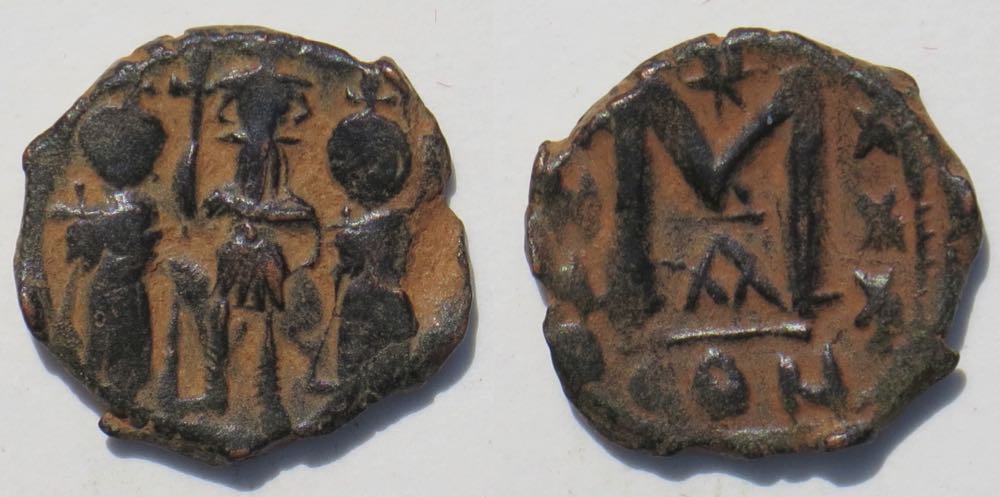 Struck year 30.
Struck year 30.
ANNO down the left, XXX down the right
CON in exergue, officina A
Note how the "NN" and the "XXX" are on either side of the "M". The previous coin switches their positions, but very neatly. It is odd that a coin as well-struck as the previous one could have such meaningless reverse legend.
The obverse has Heraclius in the middle, his son Heraclius Constantine on the right, and his wife Martina on the left, without any legend.
Sear 1668. Theophilus, 829-842. A half-follis. 23-22 mm. 3.89 grams. (The follis, Sear 1667, is nearly identical in design but larger.)
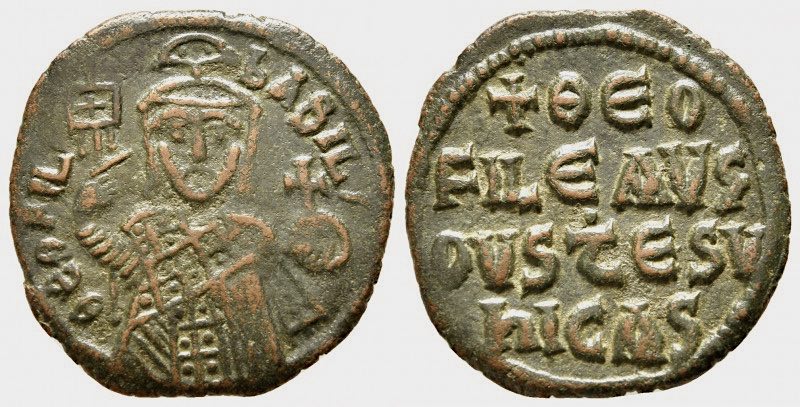 AVGOVSTЄ SV ҺICAS
AVGOVSTЄ SV ҺICAS
Reverse:
+ΘЄO Theo/phius
FILЄ AVG Aug/ustus
OVSTЄ SV may you
ҺICAS conquer
[The Є at the end of AVGOVSTЄ is the vocative ending of AVGOVSTOS]
Sear 1693. Michael III, "The Drunkard," 842-867, with Basil I, struck 866-867. 26 mm. 7.67 grams.
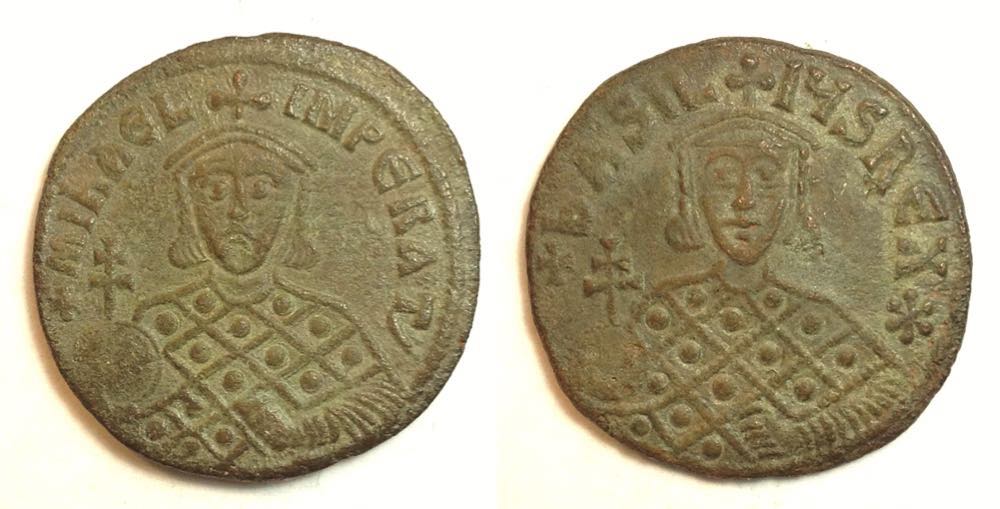 IMPЄRAT' RЄX
+MIhAЄL IMPЄRAT' (Imperator, a Roman title almost equivalent to "emperor". The slash at the end is like our apostrope denoting an omission as in "don't." )
IMPЄRAT' RЄX
+MIhAЄL IMPЄRAT' (Imperator, a Roman title almost equivalent to "emperor". The slash at the end is like our apostrope denoting an omission as in "don't." )
Bust of Michael facing in loros
bASILIUS RЄX ("RЄX" = "king" in Latin)
Bust of Basil facing in loros.
This is the only type to use the title REX.
Sear 1729. [Repeated from the first four] Leo VI, "The Wise" 886-912. 27 mm. 7.96 grams. Very common.

ЄҺ ΘЄO BASILЄVS
ROMЄOҺ
Reverse legend in four lines.
+LЄOҺ Leo
ЄҺ ΘЄO BA "by the grace of God" ["in God"]
SILЄVS R emperor of the Romans [Byzantines]
OMЄOҺ
Obverse legend: +LЄOҺ bAS-ILЄVS ROM
Leo, emperor of the Romans
Sear 1730. Leo VI and Alexander, 886-912. 27 mm. 8.46 grams.
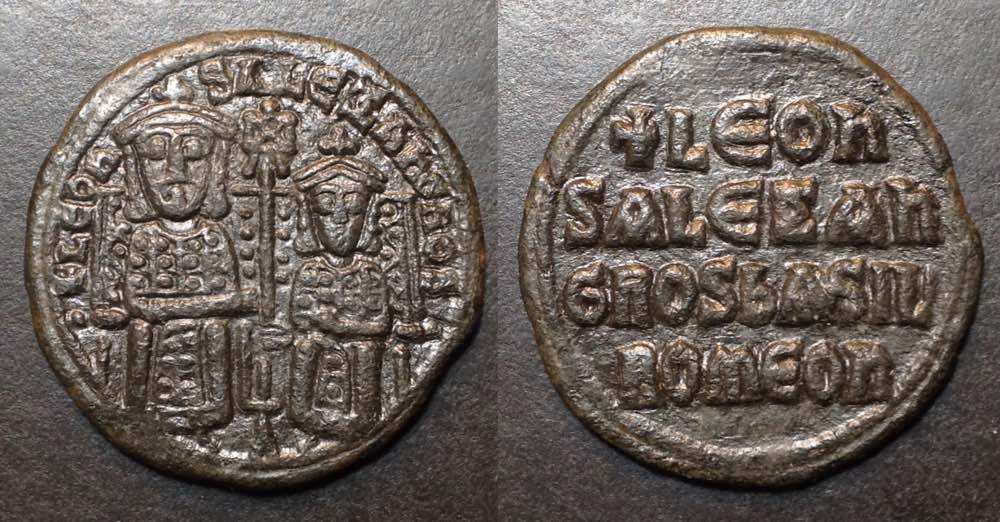 S
Reverse legend:
S
Reverse legend:
+LЄOҺ
S ALЄΞAҺ [This "S" means "with"]
GROSbASIL (the "G" here is the closest font I have to a backwards "∂", which is a Δ = D )
ROMEOҺ
"Leon [Leo] with Alexandros [Alexander]
emperors of the Romans [Byzantimes]"
Obverse legend: LЄOҺ S ALЄΞAҺGROS (same G-shape as above) "Leo with Alexander"
Sear 1754. Romanus I, Christopher, and Constantine VII. Miliaresion. 25 mm. 2.81 grams. Struck 921-931.
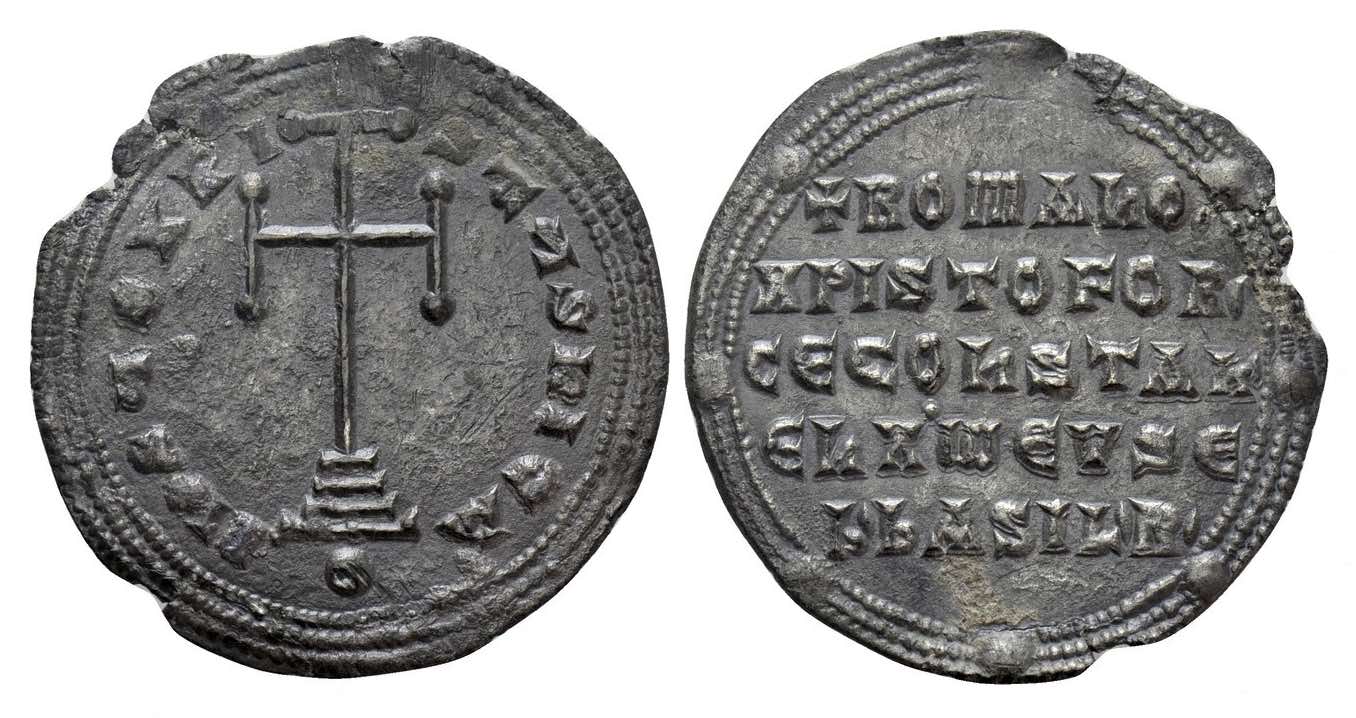 Xω ЄVSЄb
Xω X[PIST]ω = Christ
Xω ЄVSЄb
Xω X[PIST]ω = Christ
ЄVSЄb Eusebus = Pius = pious
Reverse legend:
+ROmAҺO Romanus [and]
XPISTOFOR' Christopher
CЄ COҺSTAҺ' and Constan[tine VII]
ЄҺ Xω ЄVSЄ in Christ pius [pious]
b BASIL R' emperor of the Romans
The name "Christopher" has two R's in it and this coin uses two different letter forms. The first is "P", the Greek Rho, and the second is "R", as in Latin and English.
Sear 1757. Constantine VII and Romanus II, struck c. 950-959
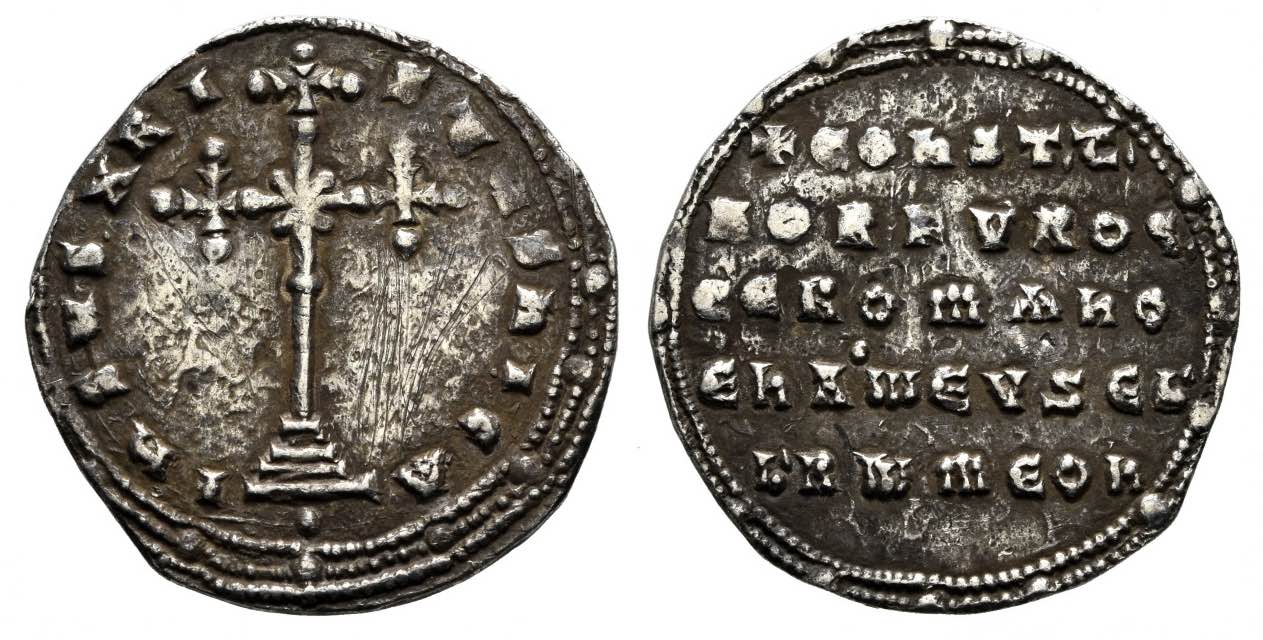 ΠORFVROΓ'
ΠORFVROΓ'
Porphyrogenitus (born in the purple)
+COҺST'T' Constantine
ΠORFVROΓ' Porphyrogenitus (born in the purple)
CЄ ROMAҺO and Romanus
ЄҺ XW ЄVSЄb' in Christ pious
b' ROMЄOҺ emperor of the Romans
Sear 1758. Constantine VII, 913-959, and Zoe (as regent), 913-919. 26-23 mm. 4.90 grams.
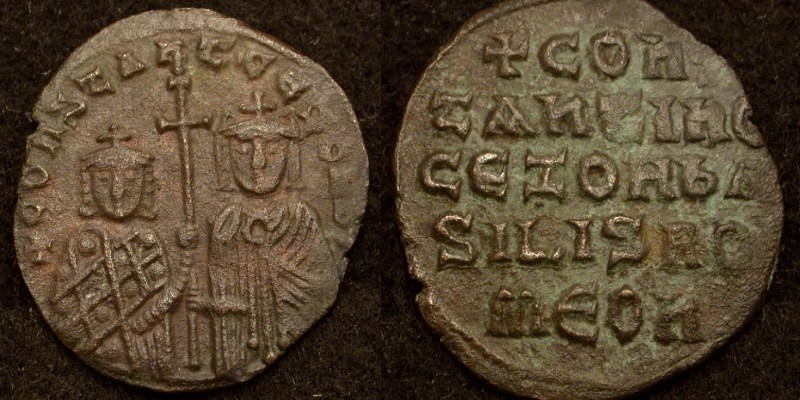 CЄ ZOH
CЄ ZOH
Reverse:
+COҺS
TAҺTIҺO (Note the "T" with the bottom curved to the right and the "N" with this shape: Һ)
CЄ ZOH bA (CЄ = "and" Zoe, his mother and regent for Constantine VII. The "C" is a "K" in the Greek word "KAI" = "and")
SILIS RO
MЄOҺ
Obverse: + CONSTAN CE ZOH b
Why does "CЄ" represent "KAI"? "C" is a version of "K". Here is the answer I got from Mike Braunlin. "In classical Greek, the word KAI was pronounced to rhyme with our word buy. In modern Greek, the same word is pronounced ke, with the dipthong αι being pronounced like the short e in pet, for example. This coin inscription shows us that by the 10th C., the word KAI was being pronounced as it is today. The CЄ on the Constantine and Zoe coin is misspelled. The correct spelling would be KAI, but the engraver spelled it as he heard it: K(C)Є." Fascinating!
Sear 1813: [A different example was illustrated in the first four] A Class A2 anonymous follis, attributed to Basil II, "The Bulgar Slayer," and his co-ruler Constantine VIII, 976-1025. 27 mm. 11.71 grams.
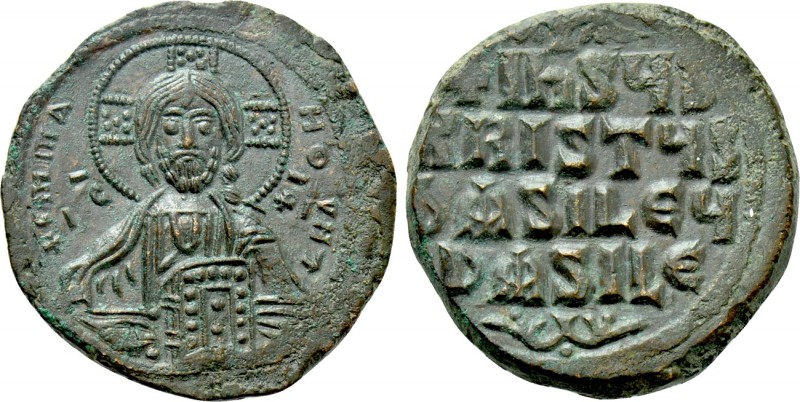 +IhSUS
+IhSUS
XRISTUS
bASILЄU
bASILЄ
Obverse legend from 8:00, around the bust of Christ.
+ЄMMA-NOVHA "God is with us"
+IhSUS (Jesus) (coin)
XRISTUS (Christ)
bASILЄU (King of [The "A" is elaborate]
bASILЄ (kings)
Perhaps more precisely, “ruler of those who rule,” but "king of kings" is commonly used.
Sear 1823. A Class B anonymous follis, attributed to Romanus III, 1028-1034. 30-27 mm. 11.04 grams.
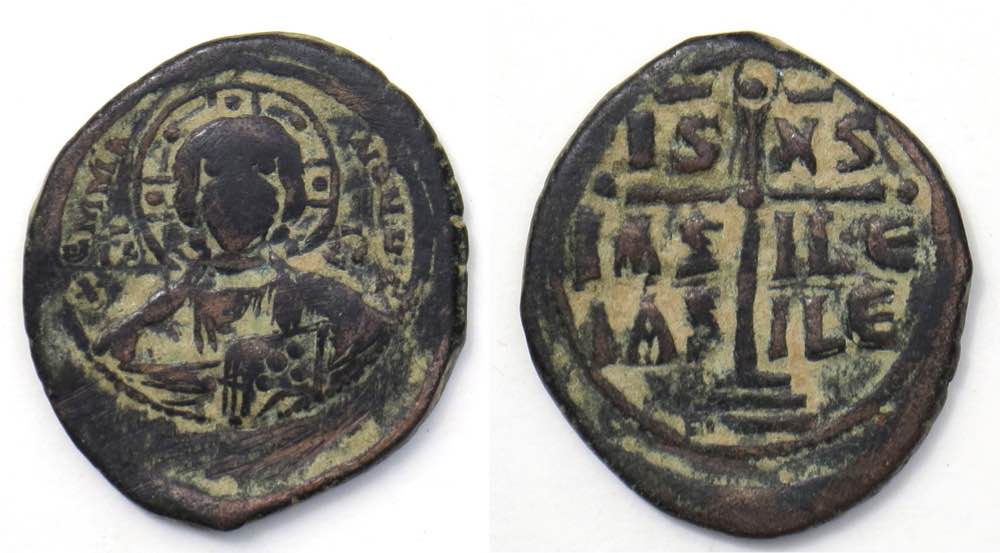 IS XS bASIL
Obverse: Bust of Christ facing,
IS XS bASIL
Obverse: Bust of Christ facing,
ЄMMA-ΛNOVHA around. "God is with us"
Reverse: IS XS with bars above (indicating an abbreviation) for "Jesus Christ"
bAS-ILЄ king
bAS-ILЄ of kings
Perhaps more precisely, “ruler of those who rule,” but "king of kings" is commonly used.
Sear 1825. A Class C anonymous follis, attributed to Michael IV, 1034-1041, by Sear or Constantine IX, 1042-1055, by Grierson in DOC. 29-26 mm. 8.44 grams.
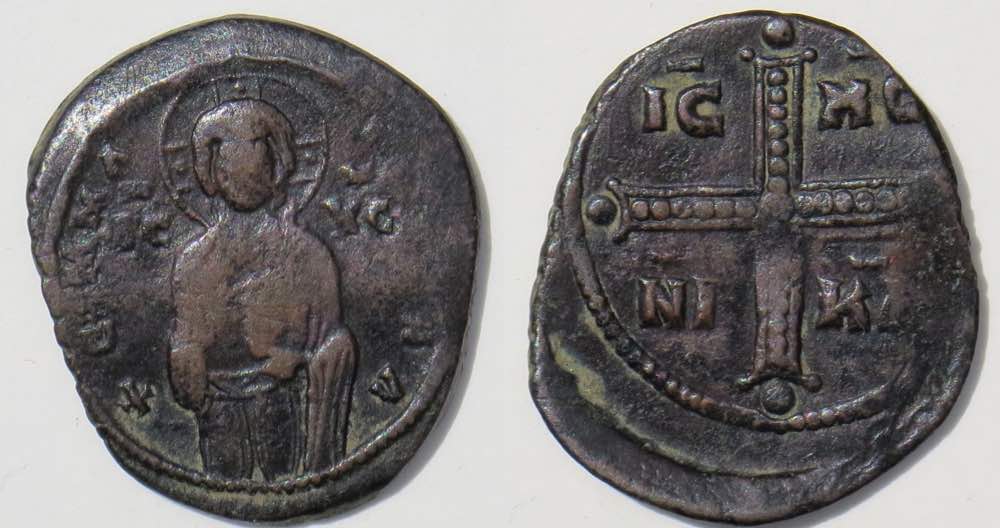
IC XC
NI KA
The reverse legend:
IC XC in the upper arms of the cross, bars above.
NI KA in the lower arms of the cross, bars above.
(The bars indicate they are abbreviations.)
"Jesus Christ
Conquers"
IC XC either side of Christ on the obverse
+ЄMMA-NOVHA "God is with us" around.
Sear 1853. Constantine X and Eudocia, 1059-1067. 29-28 mm. 10.58 grams.
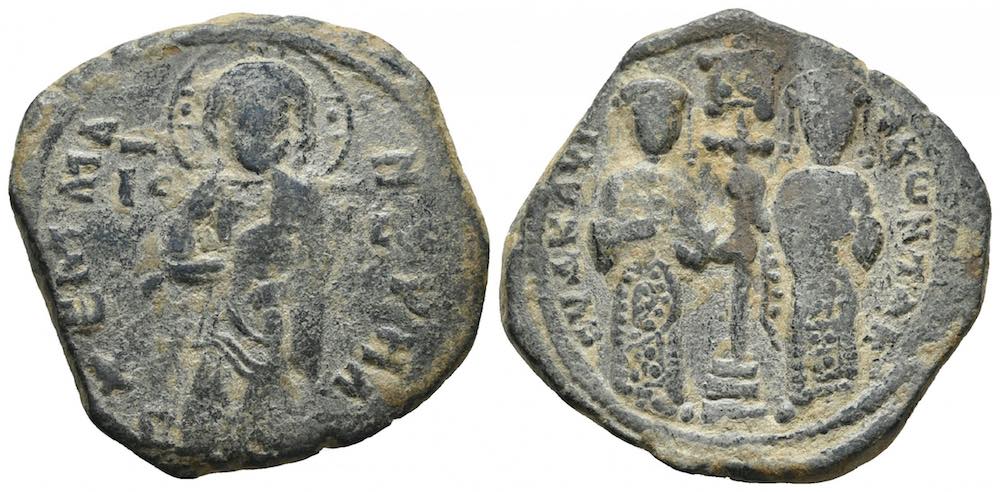 KωN
KωN
Reverse legend:
+KωN T ΔK ЄVΔK AVΓ (unusually, beginning at 1:30 on the reverse)
KωN[Σ]Τ[ΑΝΤΙΝΟΣ O] Δ[ΟY]Κ[ΑΣ] [ЄΥΔ[Ο]Κ[ΙΑ] ΑYΓ[ΟΥΣΤΟΙ] Constantine (the) Doukas, Eudocia, Augusti [or, emperors]
On the obverse "+ЄMMA-NOVHA" is "God is with us"
around Christ standing. IC XC either side.
Sear 1854. Constantine X, Ducas, 1059-1067. 27-25 mm. 8.82 grams.
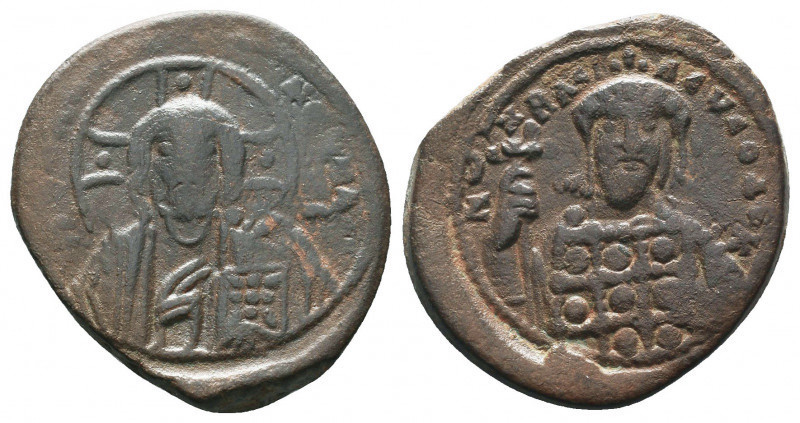
R RACIΛЄVC
Bust of Christ/Bust of Constantine X
"KωN" for "Constantine" followed (at 10:30) by
RACILЄVC O ΔVK "Basileus [= emperor] (the) Ducas" with "R" an epigraphic form of "B" and "C" a lunate "S".
Sear 1866. Romanus IV, 1068-1071. 25 mm. 5.51 grams.
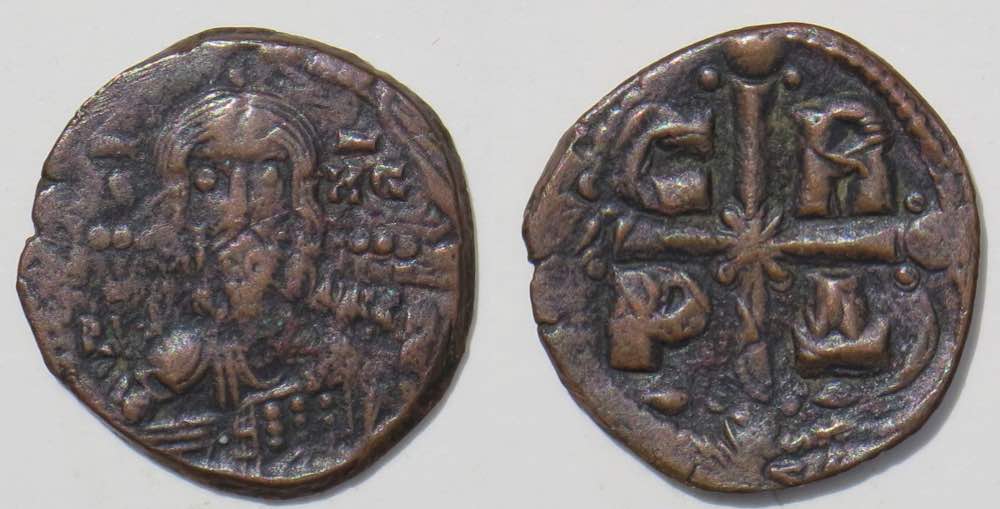 C R
C R
P Δ
The coin has the same facing bust of Christ found on anonymous folles, but the reverse has
C R ["C" is a lunate "S". "R" is an epigraphical form of "B"] ΣΤAYΡЄ BOHΘЄI "O Cross, help"
P Δ in the quadrants of a cross (with an X at the center) for
"Romanus Despot/emperor" RΩMANΩ ΔЄCΠOTH
"O cross help Romanus emperor" or
"May the cross help Romanus, emperor"
Sear 1867. An anonymous follis of Class K, attributed to Romanus IV, 1068-1071. 29-26 mm. 9.40 grams
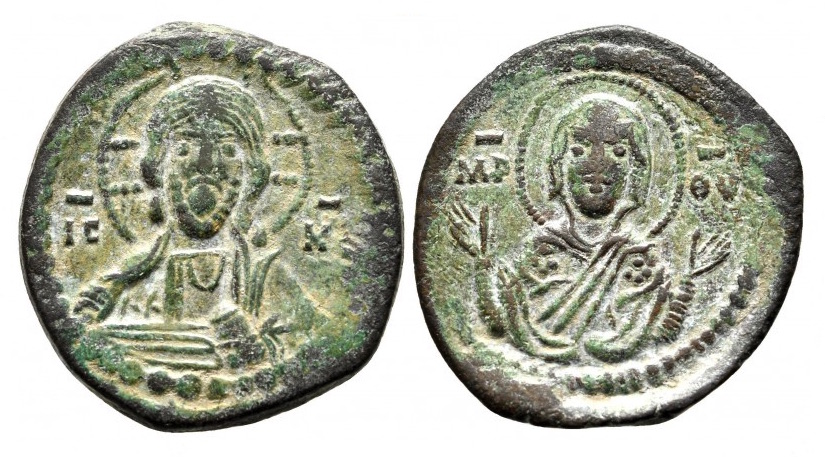
IC XC MP ΘV
Obverse bust of Christ
IC XC (with bars above, indicating an abbreviation)
Jesus Christus
Reverse bust of the Virgin Mary, "orans" (with arms spread)
MP ΘV (with bars above, indicating an abbreviation)
"Mother of God"
Sear 1888. Nicephorus III, 1078-1081. 23-22 mm. 5.55 grams.
 C Φ
C Φ
N Δ
Christ standing facing, IC XC either side, eight-pointed stars below, either side.
C Φ
N Δ
in quadrants of cross with big dot at each end. Eight-pointed star in circle.
According to Whitting, Byzantine Coins, the letters abbreviate
May the cross (C) protect (Φ)
Nicephorus (N) emperor (Δ) [Despot]
Expanded: CΦNΔ = ΣTAYPЄ ΦYLATTЄ ΝIKΗΦOPON ΔЄΣΠOTH
"O Cross, protect Nikephoros Emperor/Despot"
Sear 1911. Alexius I, 1081-1118. 26 mm. 5.8 grams.
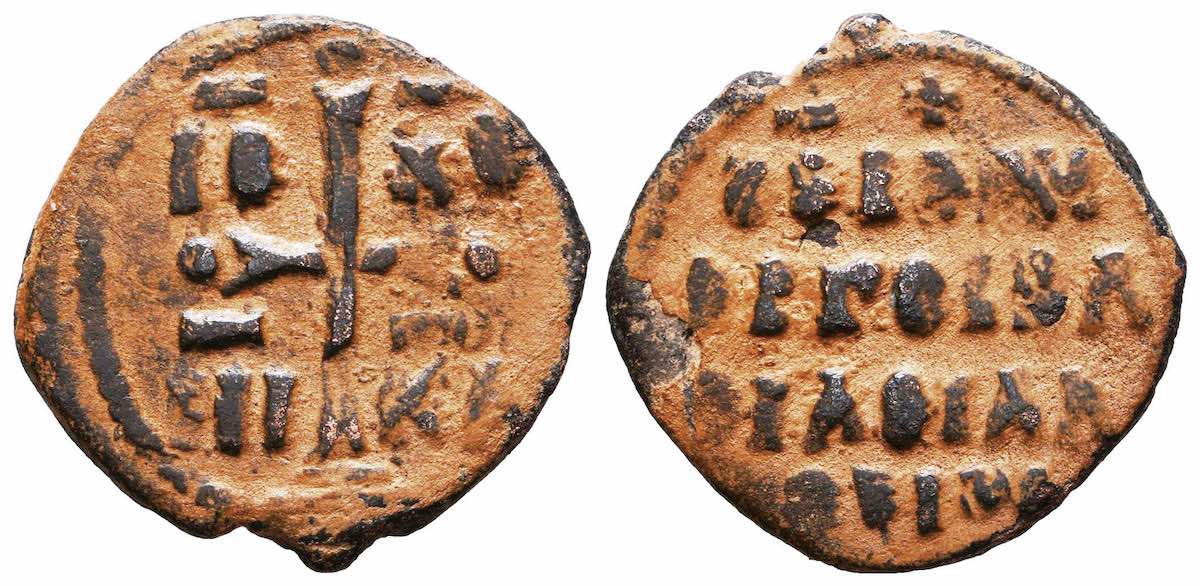 CЄP CVN
CЄP CVN
ЄPΓЄ
Reverse:
CЄP CVN Savior, assist
ЄPΓЄI BA em/peror
CILЄI AΛ Al/exius
ЄΞIω
Obverse: IC XC
NI KA in the arms of a cross
These coins are usually close to illegible.
Sear 1931. Alexius I, 1081-1118. Tetrarteron. 20-18 mm. 3.71 grams.
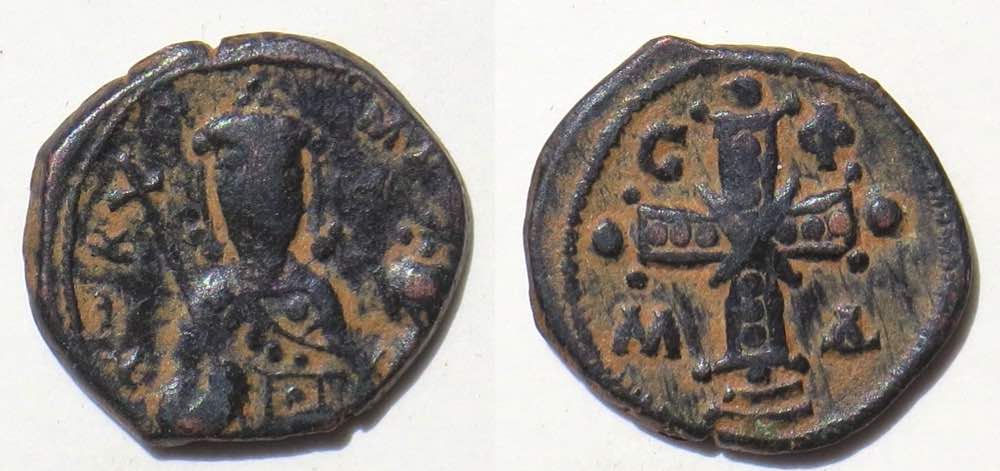 C Φ
C Φ
AΛ Δ
Bust of the emperor facing. Reverse with, in the quadrants of a jeweled cross:
C Φ (The "C" is a lunate "S" (sigma))
ΣΤAYΡЄ ΦΥΛATTЄ "O Cross, Protect"
AΛ Δ [The "AΛ" for "Alexius" looks like an "M"--the crossbar of the A is missing]
AΛЄΞION ΔЄCΠOTH. "May the cross protect (or, O Cross, protect) Alexius Despot"
Sear 1966. [Repeated from the first four] A trachy (cup-shaped coin) of Manuel I (1143-1180). 30-29 mm. 3.27 grams. Common.
 IC XC
IC XC
ΔЄCΠ
The obverse is the side that bows out. It is usually worn and double struck. On this example, the left and right sides of the head of Christ, his body, and his throne are not quite in line. That is, unfortunately, normal.
Still legible is
IC (with a bar above) to the left and XC (with a bar above) to the right. The "C" is a lunate "S". The "X" is a Greek Chi = Ch.
IC XC, abbreviates "Jesus Christus". The short bars above means they are abbreviations.
Reverse: The reverse shows the Virgin Mary crowning the emperor Manuel.
MANɣHΛ ΔЄCΠ (Manuel Despot) "Manuel" begins at 7:30. "Despot" at 3:00.
Supposedly the Virgin has M ΘV (Mother of God) with the M above and ΘV to the right. Here, only the Θ is clear at 2:30.
This reverse has at least MAN and ΔЄCΠ legible, which is more than can be read on most examples. Reverses are usually unworn--the fact the design is in the interior of the cup protects it from wear. Nevertheless, the reverses are often so ill-struck that the legends are not legible. Also, the words may have more or fewer letters spelled out. For example, ΔЄCΠ (for "despot") may omit the Π, ΔЄC, or may be longer: ΔЄCΠOT. Legends are so erratic that two coins are considered the same "type" even if their legends differ by a letter or two.
Sear 1987. Andronicus I, 1183-1185. Tetarteron. 21-17 mm. 4.39 grams.
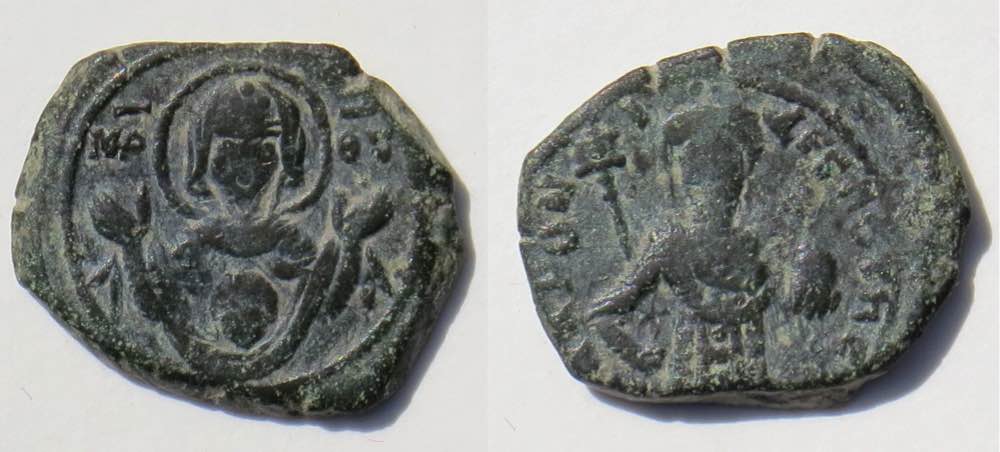 ΔЄCΠOTHC
ΔЄCΠOTHC
The Virgin, orans.
MP ΘV (with bars above, indicating an abbreviation)
"Mother of God"
Emperor standing, around
ANΔPONI ΔЄCΠOTHC
Andronicus, Despot.
Sear 2096. John III, Ducas, 1221-1254, Empire of Nicaea. 28-27 mm. 2.97 grams.
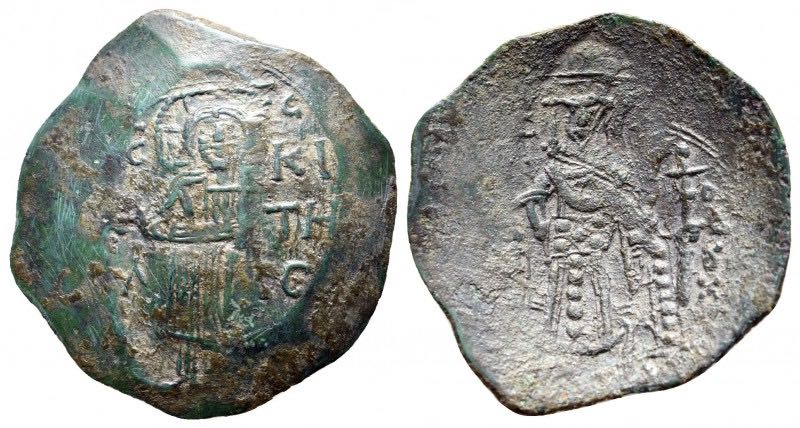 X KI
X KI
ΛΛ TH
Є
X KI
ΛΛ TH
Є "Chalkites" a particlar icon of Christ over the great gate of the Sacred Palace in Constantinople.
Sear 2116. John III, Ducas, 1221-1254, Empire of Nicaea. 19 mm. 2.07 grams.
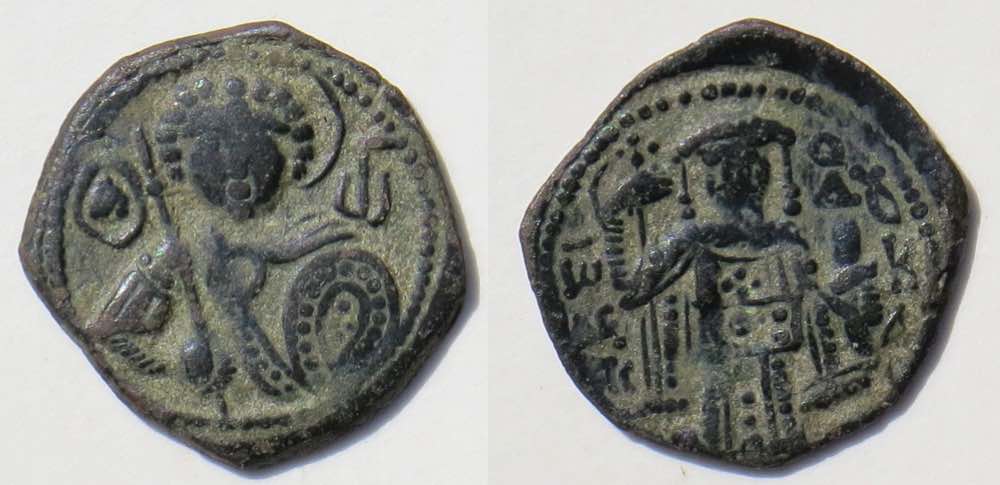 O ΔɣKAC
O ΔɣKAC
Iω bar above, for "John" to the right of St. George facing and on the reverse to the left with
ΔЄC down left. "Despot" = emperor
O ΔɣKAC down the right "[the] Ducas."
Sear 2141. Theodore II, of the Empire of Nicaea, 1254-1258. 28 mm. 4.51 grams.
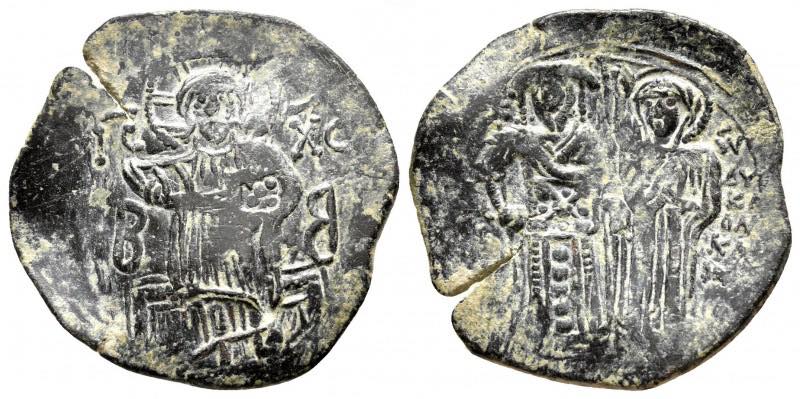 B backwards B
B backwards B
across the obverse field on either side of Christ seated.
They are a symbol of the Byzantine empire and its authority, abbreviating bASILEVS.
Down the right of the reverse is
ΔY/KA/ΛA/K
for "Ducas-Lascaris", his family names.
Sear 2141.
Sear 2167. Theodore Comnenus-Ducas, of the Empire of Thessalonica, 1224-1230. 33-28 mm. 3.10 grams. Holed. Formerly cup-shaped but now somewhat squashed.
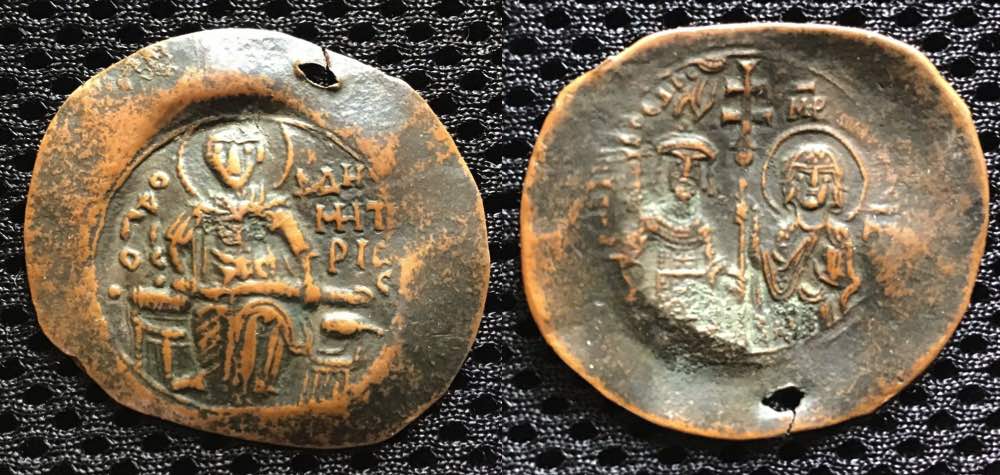 O AΓIOC ΔHMHTPIOC
O AΓIOC ΔHMHTPIOC
ΔHMHTPIOC down right "Demetrius"
Seated figure of St. Demetrius
ΘЄOΔωPOC ΔЄC "Theodore, Despot"
Theodore on left, Mary on the right, MP (Mother of God) above.
Problem coins. Sometimes an important part of the legend is off the flan.
Sear 167. 13-12 mm. 2.04 grams.
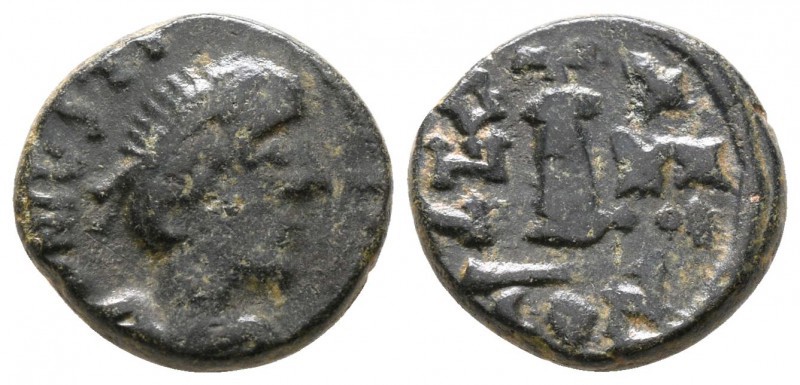 This small coin, a decanummium, with "I" for ten, has obverse legend
This small coin, a decanummium, with "I" for ten, has obverse legend
...NIVSTI ....
which could belong to either Justin or Justinian. In the case, we can use the year which is on coins of Justinian, but not on coins of Justin, to confirm its attribution to Justinian.
References: http://augustuscoins.com/ed/catalogs/Byzantine.html
Especially useful are Sear, The Dumbarton Oaks Collection catalogs, and the three volumes of MIB by Hahn.
Acknowledgement: I am not an expert on Byzantine coin legends, but my good friend Mike Braunlin is. He knows both Greek and Latin and has helped me again and again with many tricky points. Thank you very much, Mike!
The end.
I solicit questions, corrections, or suggestions. Contact me at  I'd especially appreciate hearing about words that are on copper coins but not listed above. Include, if you can, their translations and their Sear numbers.
I'd especially appreciate hearing about words that are on copper coins but not listed above. Include, if you can, their translations and their Sear numbers.
Posted June 7, 2021. Updated, June 10, 2021. July 5, 2021. July 26, 2021. Minor additions Dec. 8, 2022. Image sizes increased Dec. 12, 2024.
Go to the page "Introduction to Byzantine coins (491-1453)"
Go the the main Table of Contents of this educational site.
Here is an (off-site) site on reading Roman coins:
For Roman legends, see here: http://www.bitsofhistory.com/info/roman_inscriptions.html
Here is an (off-site) article on reading Greek coins:
https://coinweek.com/ancient-coins/reading-ancient-greek-coins/
 The obverse legend gives the emperor's name and titles, clockwise from 7:30:
The obverse legend gives the emperor's name and titles, clockwise from 7:30: . Similar coins may have officina number "B" (Beta) for "2", "Γ" (Gamma) for "3", "Δ" (Delta) for "4" or "Є" (Epsilon) for "5".
. Similar coins may have officina number "B" (Beta) for "2", "Γ" (Gamma) for "3", "Δ" (Delta) for "4" or "Є" (Epsilon) for "5". 
 Reverse: Legend in four lines with ornaments above and below.
Reverse: Legend in four lines with ornaments above and below. The obverse is the side that bows out. It is usually worn and double struck. On this example, the left and right sides of the head of Christ, his body, and his throne are not quite in line. That is, unfortunately, normal.
The obverse is the side that bows out. It is usually worn and double struck. On this example, the left and right sides of the head of Christ, his body, and his throne are not quite in line. That is, unfortunately, normal.  (
( = 6. So 7 can be "GI" (
= 6. So 7 can be "GI" ( .
. (
(
 IS
IS 


 I
I  B
B  A
A

 NM I VITA
NM I VITA  ɥ Γ m
ɥ Γ m 
 H
H

 PERP AVC
PERP AVC  KYΠPI
KYΠPI S
S  ∂ЄЧS A∂IЧTA
∂ЄЧS A∂IЧTA  O
O ЄN TɣTo NIKA
ЄN TɣTo NIKA IhSɥS XPISTɥS ҺICA
IhSɥS XPISTɥS ҺICA X N
X N Struck year 30.
Struck year 30. AVGOVSTЄ SV ҺICAS
AVGOVSTЄ SV ҺICAS 
 S
S Xω ЄVSЄb
Xω ЄVSЄb 
 CЄ ZOH
CЄ ZOH  +IhSUS
+IhSUS  IS XS bASIL
IS XS bASIL 
 KωN
KωN 
 C R
C R
 C Φ
C Φ CЄP CVN
CЄP CVN  C Φ
C Φ ΔЄCΠOTHC
ΔЄCΠOTHC  X KI
X KI O ΔɣKAC
O ΔɣKAC  B backwards B
B backwards B  O AΓIOC ΔHMHTPIOC
O AΓIOC ΔHMHTPIOC  This small coin, a decanummium, with "I" for ten, has obverse legend
This small coin, a decanummium, with "I" for ten, has obverse legend I'd especially appreciate hearing about words that are on copper coins but not listed above. Include, if you can, their translations and their Sear numbers.
I'd especially appreciate hearing about words that are on copper coins but not listed above. Include, if you can, their translations and their Sear numbers.